Employee Absenteeism: Impact on Absence Management in Healthcares
VerifiedAdded on 2023/06/15
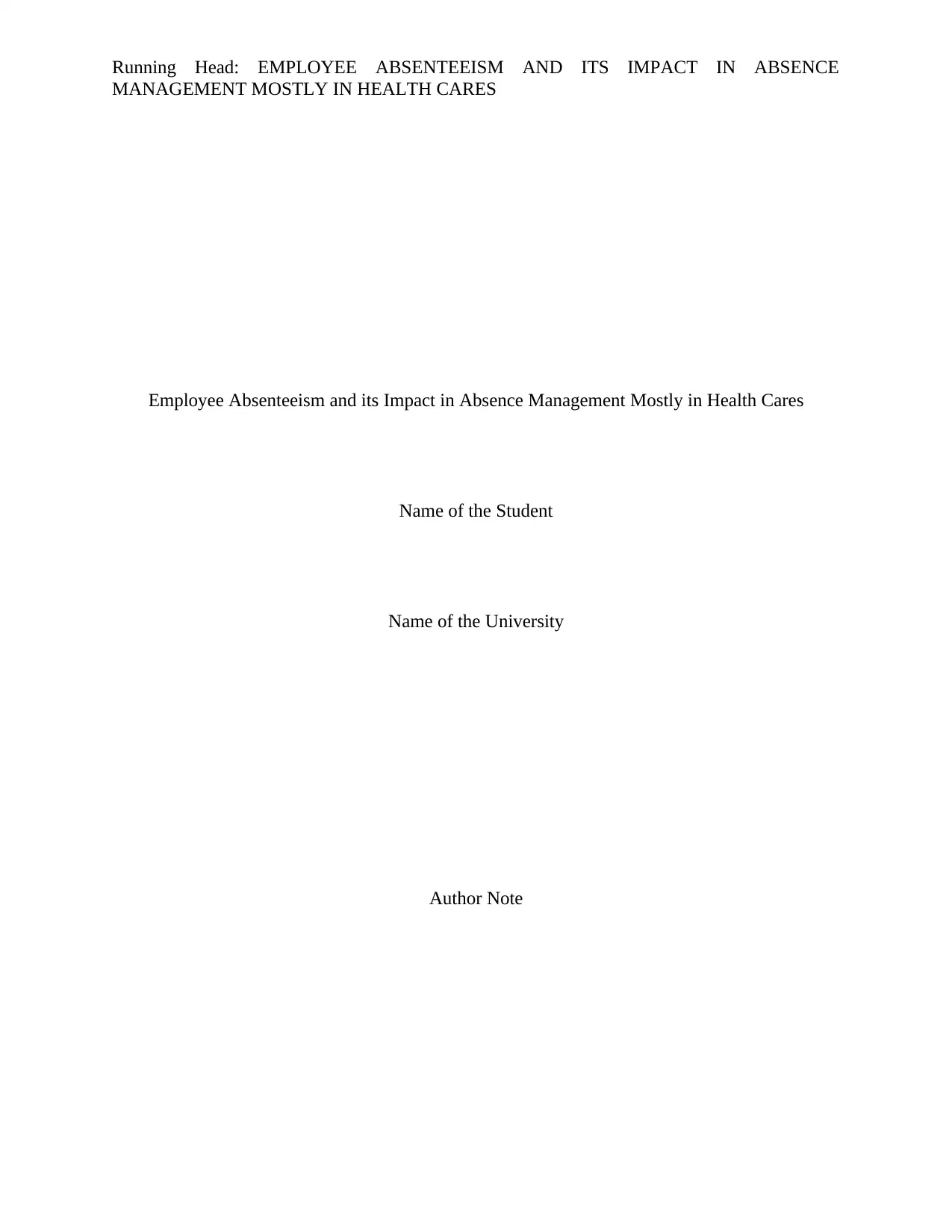
MANAGEMENT MOSTLY IN HEALTH CARES
Employee Absenteeism and its Impact in Absence Management Mostly in Health Cares
Name of the Student
Name of the University
Author Note
Paraphrase This Document
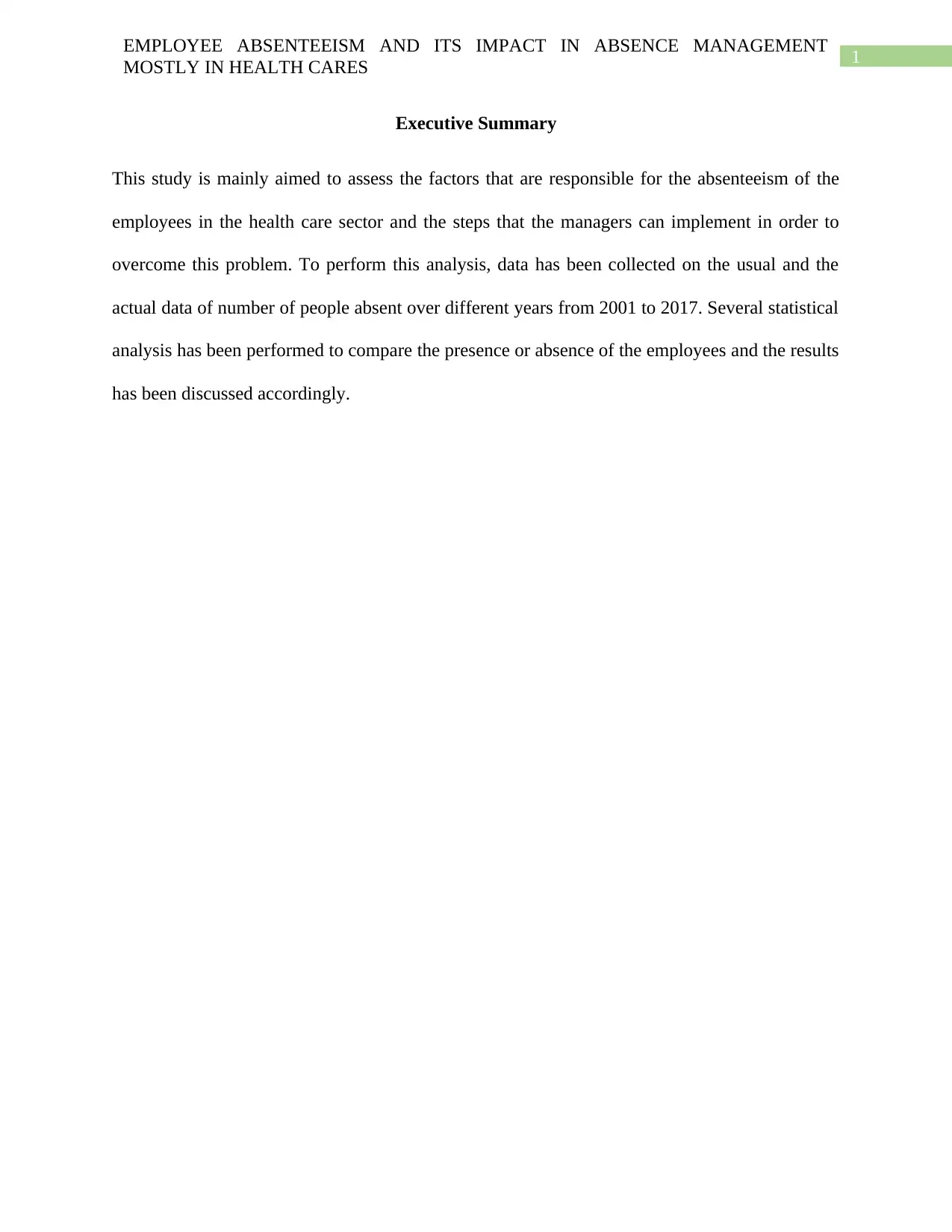
EMPLOYEE ABSENTEEISM AND ITS IMPACT IN ABSENCE MANAGEMENT
MOSTLY IN HEALTH CARES
Executive Summary
This study is mainly aimed to assess the factors that are responsible for the absenteeism of the
employees in the health care sector and the steps that the managers can implement in order to
overcome this problem. To perform this analysis, data has been collected on the usual and the
actual data of number of people absent over different years from 2001 to 2017. Several statistical
analysis has been performed to compare the presence or absence of the employees and the results
has been discussed accordingly.
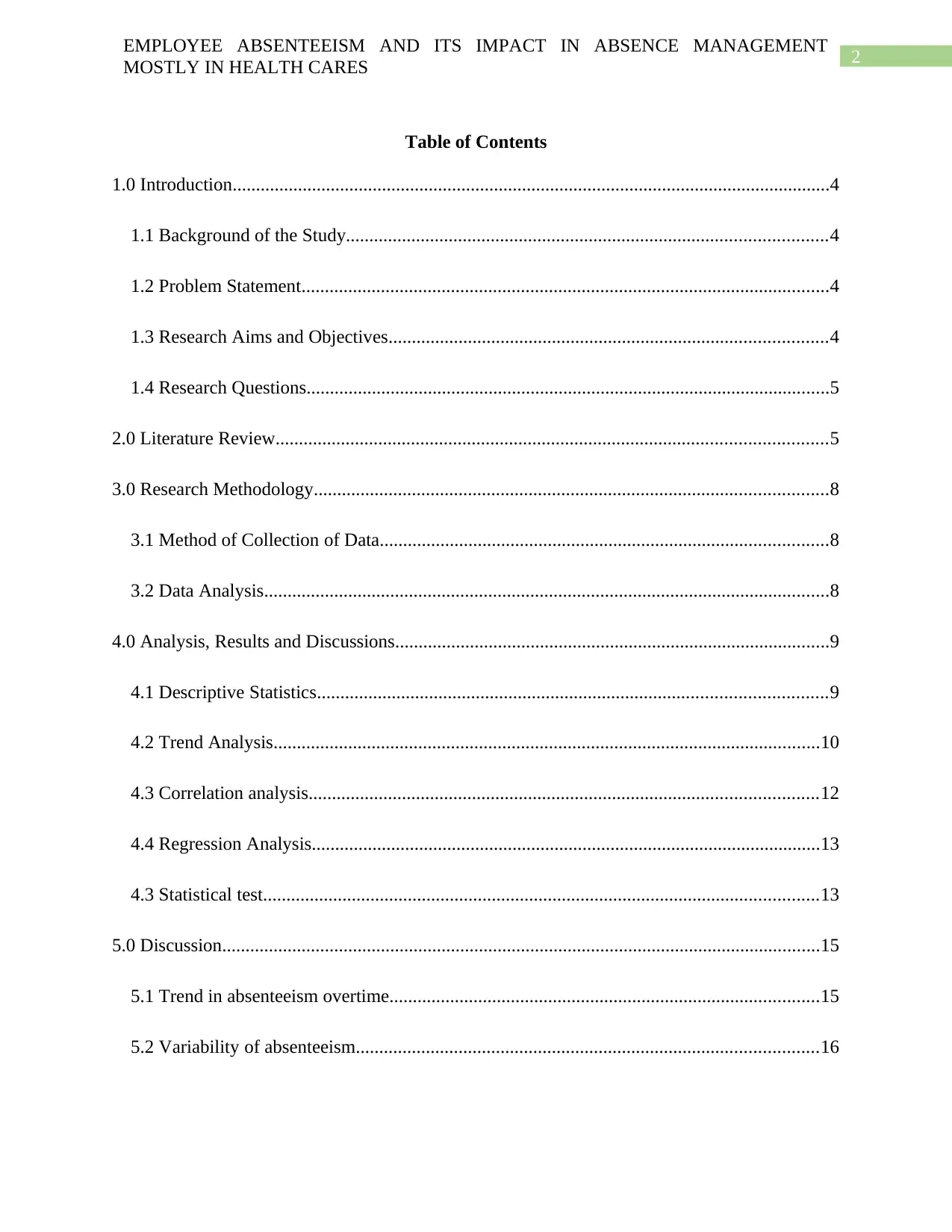
EMPLOYEE ABSENTEEISM AND ITS IMPACT IN ABSENCE MANAGEMENT
MOSTLY IN HEALTH CARES
Table of Contents
1.0 Introduction................................................................................................................................4
1.1 Background of the Study.......................................................................................................4
1.2 Problem Statement.................................................................................................................4
1.3 Research Aims and Objectives..............................................................................................4
1.4 Research Questions................................................................................................................5
2.0 Literature Review......................................................................................................................5
3.0 Research Methodology..............................................................................................................8
3.1 Method of Collection of Data................................................................................................8
3.2 Data Analysis.........................................................................................................................8
4.0 Analysis, Results and Discussions.............................................................................................9
4.1 Descriptive Statistics.............................................................................................................9
4.2 Trend Analysis.....................................................................................................................10
4.3 Correlation analysis.............................................................................................................12
4.4 Regression Analysis.............................................................................................................13
4.3 Statistical test.......................................................................................................................13
5.0 Discussion................................................................................................................................15
5.1 Trend in absenteeism overtime............................................................................................15
5.2 Variability of absenteeism...................................................................................................16
⊘ This is a preview!⊘
Do you want full access?
Subscribe today to unlock all pages.

Trusted by 1+ million students worldwide
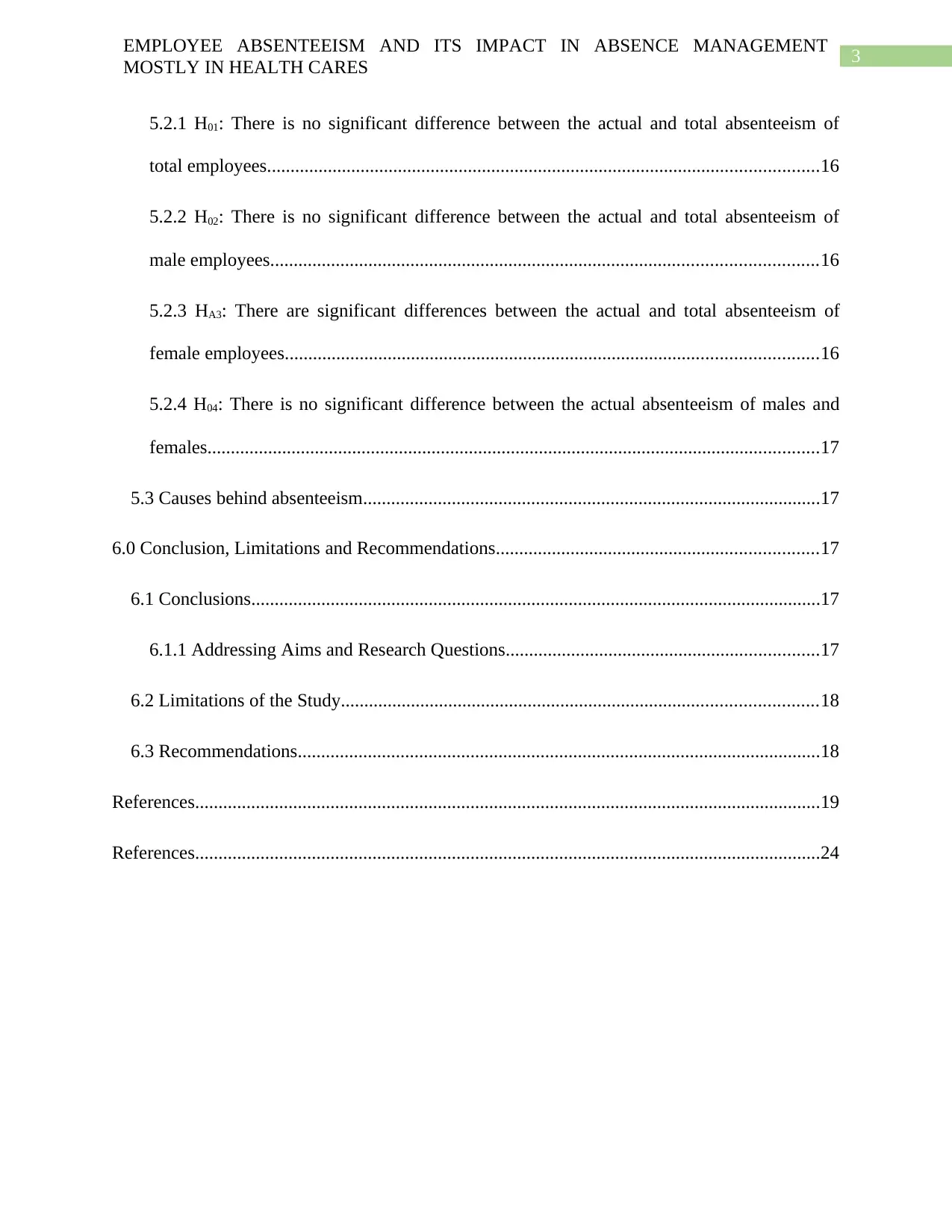
EMPLOYEE ABSENTEEISM AND ITS IMPACT IN ABSENCE MANAGEMENT
MOSTLY IN HEALTH CARES
5.2.1 H01: There is no significant difference between the actual and total absenteeism of
total employees......................................................................................................................16
5.2.2 H02: There is no significant difference between the actual and total absenteeism of
male employees.....................................................................................................................16
5.2.3 HA3: There are significant differences between the actual and total absenteeism of
female employees..................................................................................................................16
5.2.4 H04: There is no significant difference between the actual absenteeism of males and
females...................................................................................................................................17
5.3 Causes behind absenteeism..................................................................................................17
6.0 Conclusion, Limitations and Recommendations.....................................................................17
6.1 Conclusions..........................................................................................................................17
6.1.1 Addressing Aims and Research Questions...................................................................17
6.2 Limitations of the Study......................................................................................................18
6.3 Recommendations................................................................................................................18
References......................................................................................................................................19
References......................................................................................................................................24
Paraphrase This Document
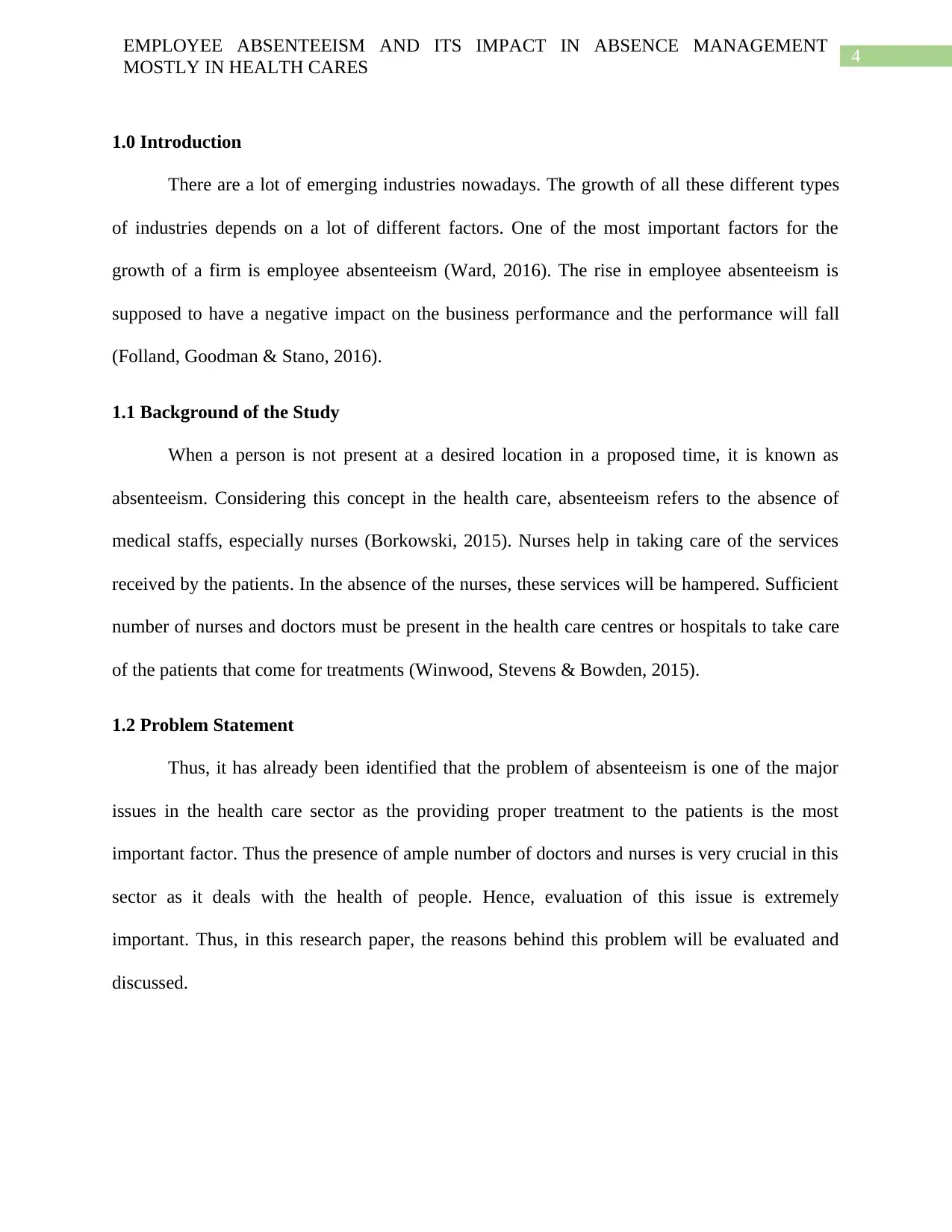
EMPLOYEE ABSENTEEISM AND ITS IMPACT IN ABSENCE MANAGEMENT
MOSTLY IN HEALTH CARES
1.0 Introduction
There are a lot of emerging industries nowadays. The growth of all these different types
of industries depends on a lot of different factors. One of the most important factors for the
growth of a firm is employee absenteeism (Ward, 2016). The rise in employee absenteeism is
supposed to have a negative impact on the business performance and the performance will fall
(Folland, Goodman & Stano, 2016).
1.1 Background of the Study
When a person is not present at a desired location in a proposed time, it is known as
absenteeism. Considering this concept in the health care, absenteeism refers to the absence of
medical staffs, especially nurses (Borkowski, 2015). Nurses help in taking care of the services
received by the patients. In the absence of the nurses, these services will be hampered. Sufficient
number of nurses and doctors must be present in the health care centres or hospitals to take care
of the patients that come for treatments (Winwood, Stevens & Bowden, 2015).
1.2 Problem Statement
Thus, it has already been identified that the problem of absenteeism is one of the major
issues in the health care sector as the providing proper treatment to the patients is the most
important factor. Thus the presence of ample number of doctors and nurses is very crucial in this
sector as it deals with the health of people. Hence, evaluation of this issue is extremely
important. Thus, in this research paper, the reasons behind this problem will be evaluated and
discussed.
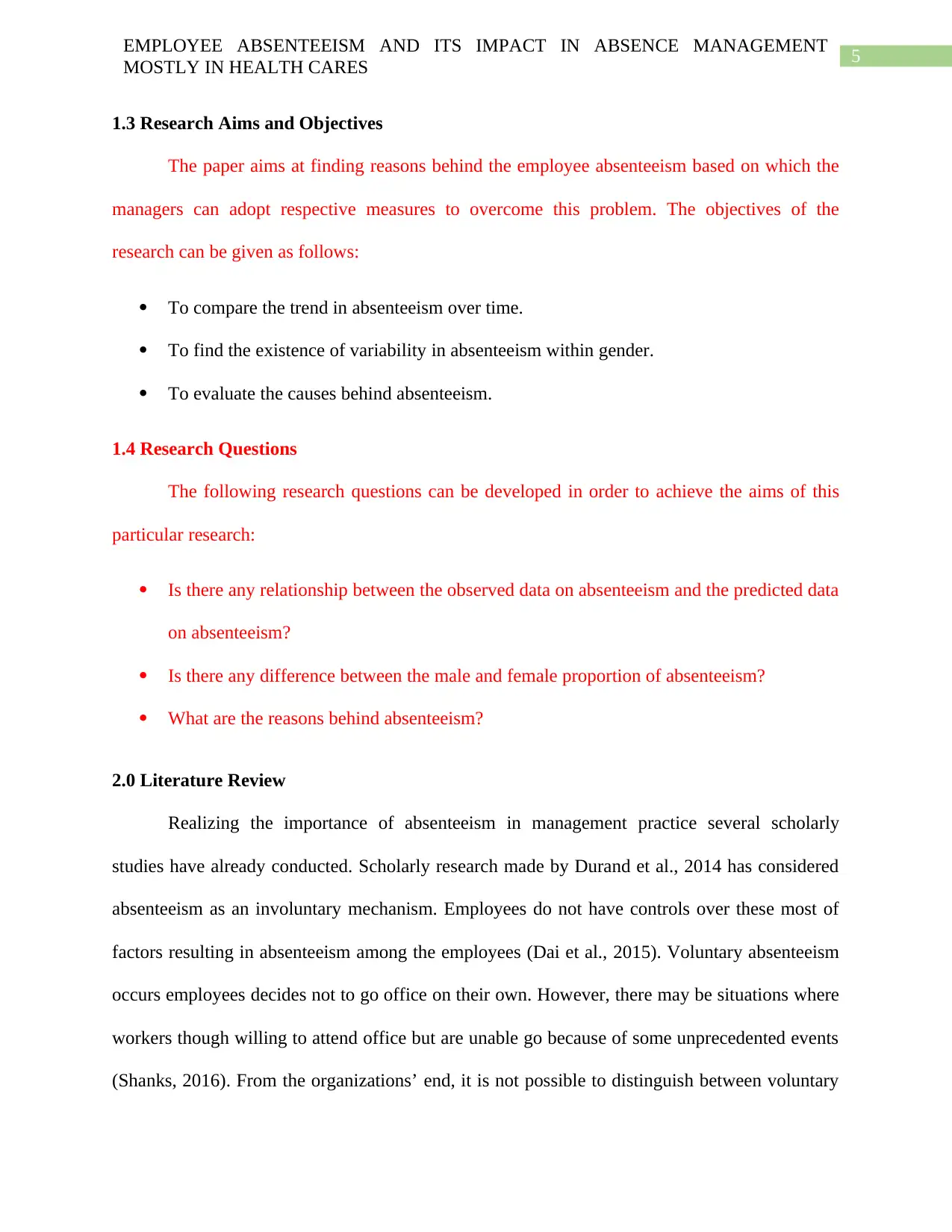
EMPLOYEE ABSENTEEISM AND ITS IMPACT IN ABSENCE MANAGEMENT
MOSTLY IN HEALTH CARES
1.3 Research Aims and Objectives
The paper aims at finding reasons behind the employee absenteeism based on which the
managers can adopt respective measures to overcome this problem. The objectives of the
research can be given as follows:
To compare the trend in absenteeism over time.
To find the existence of variability in absenteeism within gender.
To evaluate the causes behind absenteeism.
1.4 Research Questions
The following research questions can be developed in order to achieve the aims of this
particular research:
Is there any relationship between the observed data on absenteeism and the predicted data
on absenteeism?
Is there any difference between the male and female proportion of absenteeism?
What are the reasons behind absenteeism?
2.0 Literature Review
Realizing the importance of absenteeism in management practice several scholarly
studies have already conducted. Scholarly research made by Durand et al., 2014 has considered
absenteeism as an involuntary mechanism. Employees do not have controls over these most of
factors resulting in absenteeism among the employees (Dai et al., 2015). Voluntary absenteeism
occurs employees decides not to go office on their own. However, there may be situations where
workers though willing to attend office but are unable go because of some unprecedented events
(Shanks, 2016). From the organizations’ end, it is not possible to distinguish between voluntary
⊘ This is a preview!⊘
Do you want full access?
Subscribe today to unlock all pages.

Trusted by 1+ million students worldwide
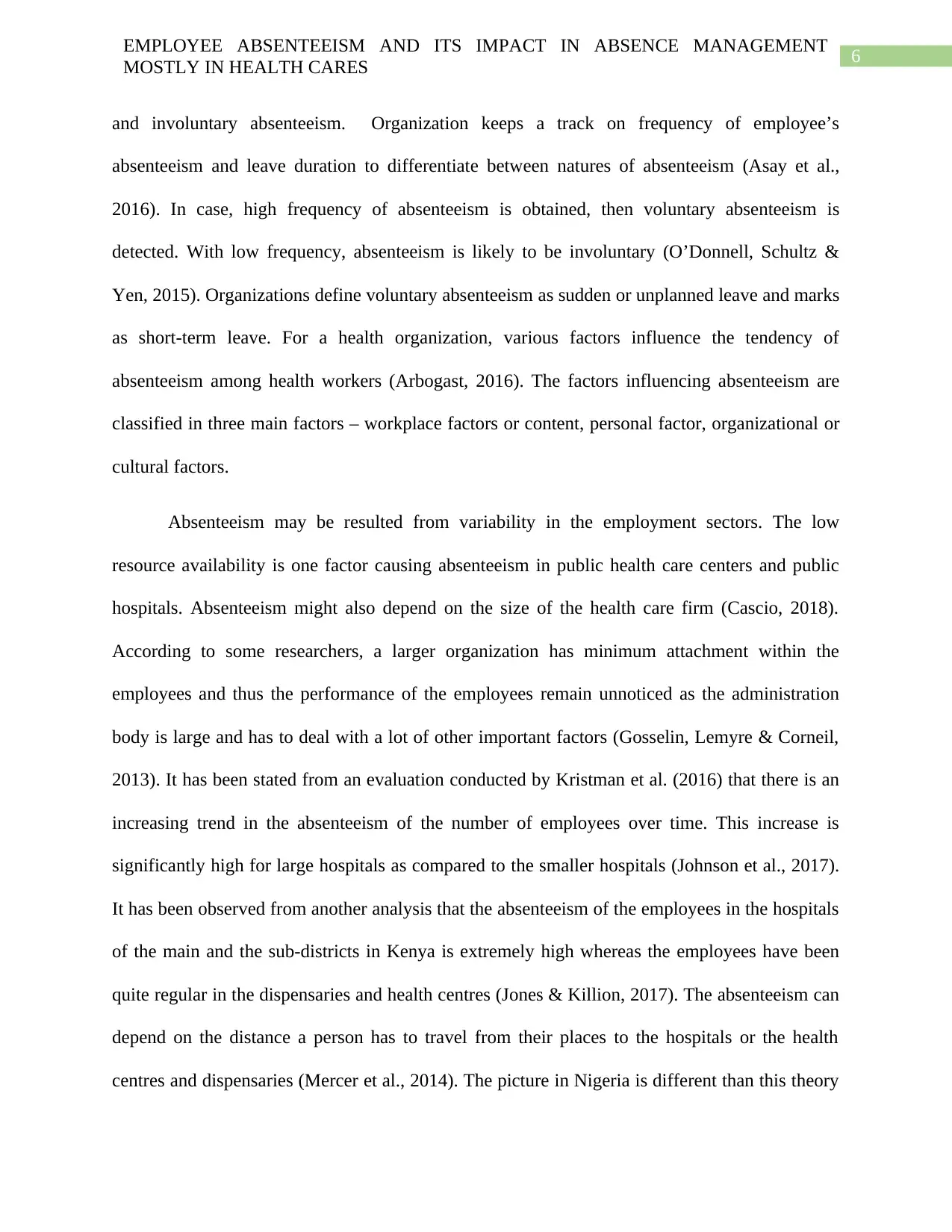
EMPLOYEE ABSENTEEISM AND ITS IMPACT IN ABSENCE MANAGEMENT
MOSTLY IN HEALTH CARES
and involuntary absenteeism. Organization keeps a track on frequency of employee’s
absenteeism and leave duration to differentiate between natures of absenteeism (Asay et al.,
2016). In case, high frequency of absenteeism is obtained, then voluntary absenteeism is
detected. With low frequency, absenteeism is likely to be involuntary (O’Donnell, Schultz &
Yen, 2015). Organizations define voluntary absenteeism as sudden or unplanned leave and marks
as short-term leave. For a health organization, various factors influence the tendency of
absenteeism among health workers (Arbogast, 2016). The factors influencing absenteeism are
classified in three main factors – workplace factors or content, personal factor, organizational or
cultural factors.
Absenteeism may be resulted from variability in the employment sectors. The low
resource availability is one factor causing absenteeism in public health care centers and public
hospitals. Absenteeism might also depend on the size of the health care firm (Cascio, 2018).
According to some researchers, a larger organization has minimum attachment within the
employees and thus the performance of the employees remain unnoticed as the administration
body is large and has to deal with a lot of other important factors (Gosselin, Lemyre & Corneil,
2013). It has been stated from an evaluation conducted by Kristman et al. (2016) that there is an
increasing trend in the absenteeism of the number of employees over time. This increase is
significantly high for large hospitals as compared to the smaller hospitals (Johnson et al., 2017).
It has been observed from another analysis that the absenteeism of the employees in the hospitals
of the main and the sub-districts in Kenya is extremely high whereas the employees have been
quite regular in the dispensaries and health centres (Jones & Killion, 2017). The absenteeism can
depend on the distance a person has to travel from their places to the hospitals or the health
centres and dispensaries (Mercer et al., 2014). The picture in Nigeria is different than this theory
Paraphrase This Document
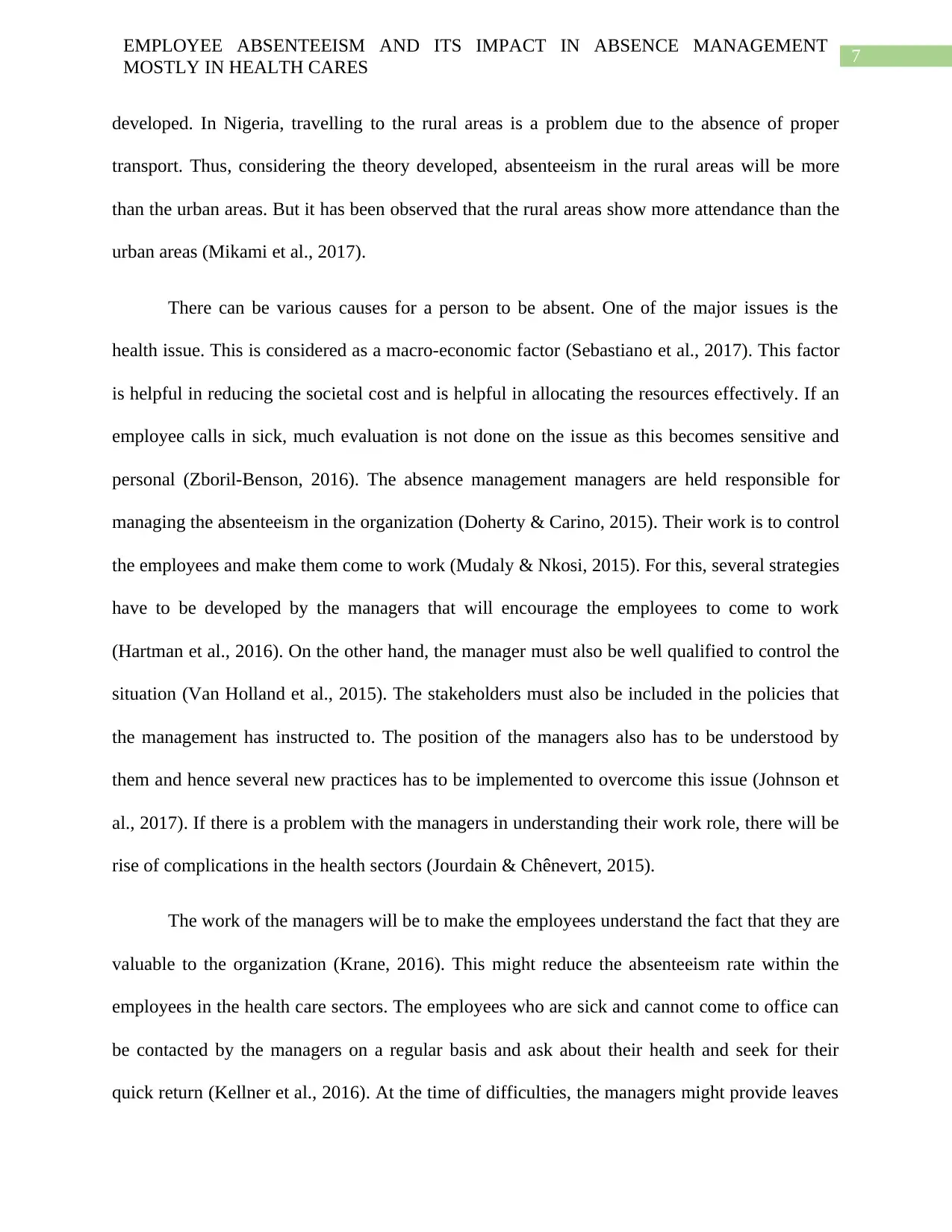
EMPLOYEE ABSENTEEISM AND ITS IMPACT IN ABSENCE MANAGEMENT
MOSTLY IN HEALTH CARES
developed. In Nigeria, travelling to the rural areas is a problem due to the absence of proper
transport. Thus, considering the theory developed, absenteeism in the rural areas will be more
than the urban areas. But it has been observed that the rural areas show more attendance than the
urban areas (Mikami et al., 2017).
There can be various causes for a person to be absent. One of the major issues is the
health issue. This is considered as a macro-economic factor (Sebastiano et al., 2017). This factor
is helpful in reducing the societal cost and is helpful in allocating the resources effectively. If an
employee calls in sick, much evaluation is not done on the issue as this becomes sensitive and
personal (Zboril-Benson, 2016). The absence management managers are held responsible for
managing the absenteeism in the organization (Doherty & Carino, 2015). Their work is to control
the employees and make them come to work (Mudaly & Nkosi, 2015). For this, several strategies
have to be developed by the managers that will encourage the employees to come to work
(Hartman et al., 2016). On the other hand, the manager must also be well qualified to control the
situation (Van Holland et al., 2015). The stakeholders must also be included in the policies that
the management has instructed to. The position of the managers also has to be understood by
them and hence several new practices has to be implemented to overcome this issue (Johnson et
al., 2017). If there is a problem with the managers in understanding their work role, there will be
rise of complications in the health sectors (Jourdain & Chênevert, 2015).
The work of the managers will be to make the employees understand the fact that they are
valuable to the organization (Krane, 2016). This might reduce the absenteeism rate within the
employees in the health care sectors. The employees who are sick and cannot come to office can
be contacted by the managers on a regular basis and ask about their health and seek for their
quick return (Kellner et al., 2016). At the time of difficulties, the managers might provide leaves
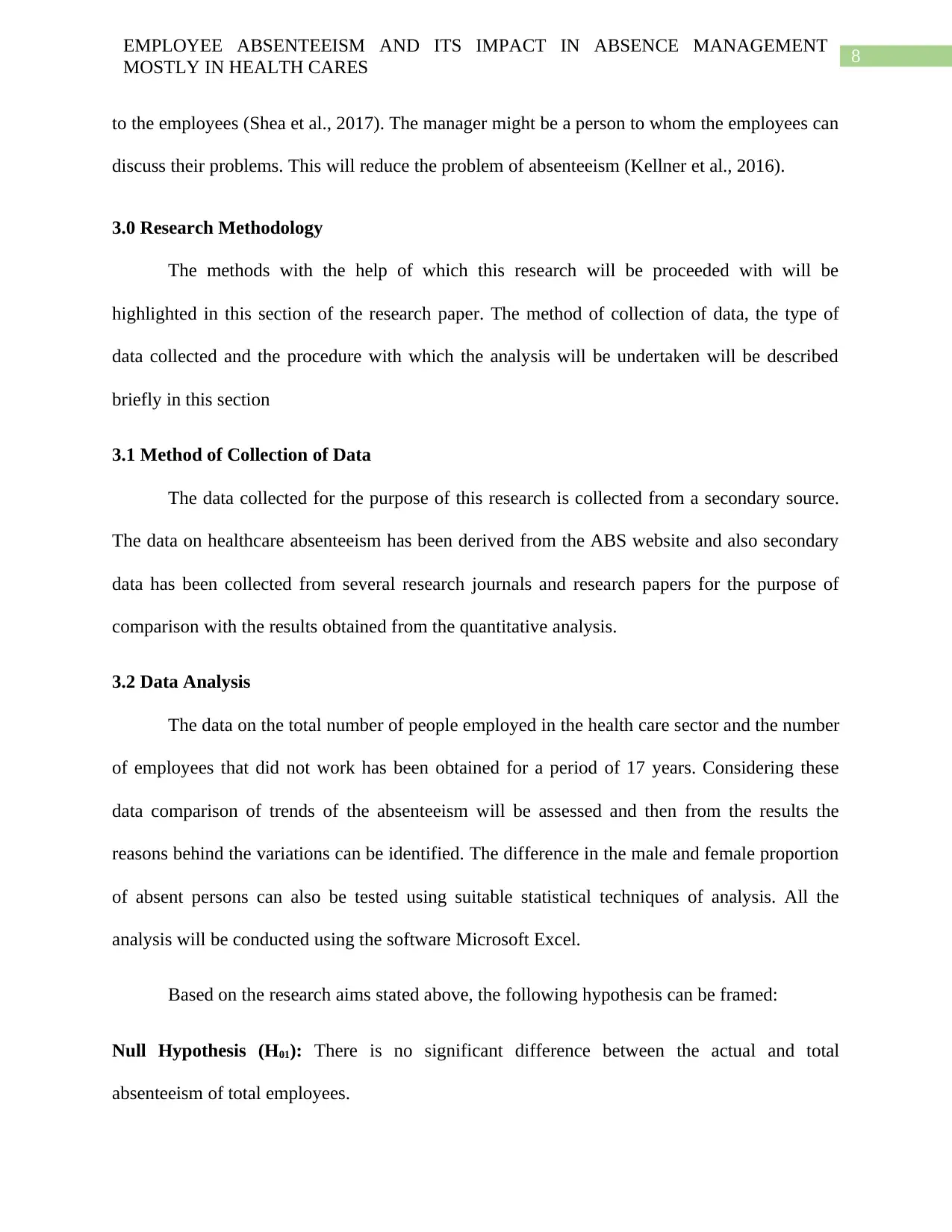
EMPLOYEE ABSENTEEISM AND ITS IMPACT IN ABSENCE MANAGEMENT
MOSTLY IN HEALTH CARES
to the employees (Shea et al., 2017). The manager might be a person to whom the employees can
discuss their problems. This will reduce the problem of absenteeism (Kellner et al., 2016).
3.0 Research Methodology
The methods with the help of which this research will be proceeded with will be
highlighted in this section of the research paper. The method of collection of data, the type of
data collected and the procedure with which the analysis will be undertaken will be described
briefly in this section
3.1 Method of Collection of Data
The data collected for the purpose of this research is collected from a secondary source.
The data on healthcare absenteeism has been derived from the ABS website and also secondary
data has been collected from several research journals and research papers for the purpose of
comparison with the results obtained from the quantitative analysis.
3.2 Data Analysis
The data on the total number of people employed in the health care sector and the number
of employees that did not work has been obtained for a period of 17 years. Considering these
data comparison of trends of the absenteeism will be assessed and then from the results the
reasons behind the variations can be identified. The difference in the male and female proportion
of absent persons can also be tested using suitable statistical techniques of analysis. All the
analysis will be conducted using the software Microsoft Excel.
Based on the research aims stated above, the following hypothesis can be framed:
Null Hypothesis (H01): There is no significant difference between the actual and total
absenteeism of total employees.
⊘ This is a preview!⊘
Do you want full access?
Subscribe today to unlock all pages.

Trusted by 1+ million students worldwide
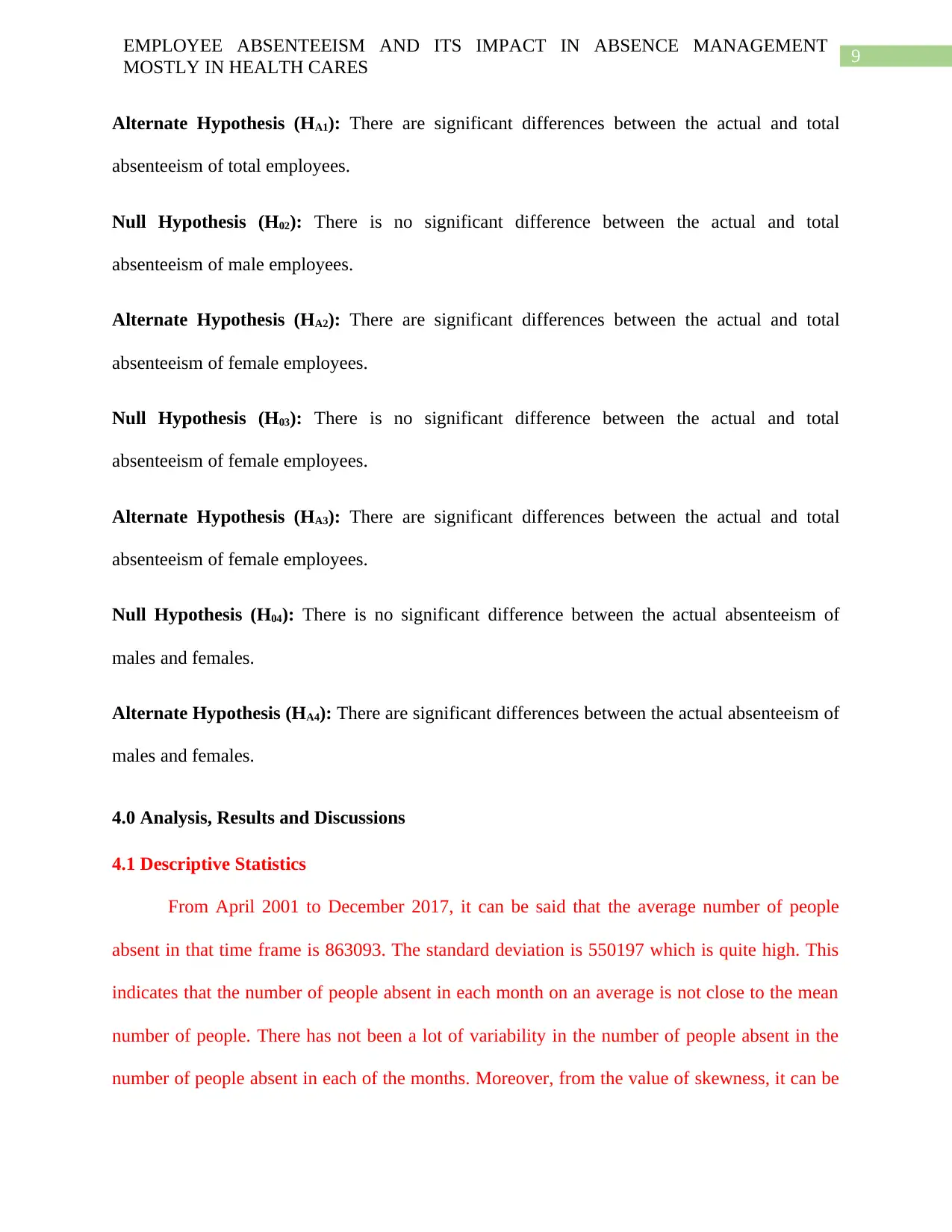
EMPLOYEE ABSENTEEISM AND ITS IMPACT IN ABSENCE MANAGEMENT
MOSTLY IN HEALTH CARES
Alternate Hypothesis (HA1): There are significant differences between the actual and total
absenteeism of total employees.
Null Hypothesis (H02): There is no significant difference between the actual and total
absenteeism of male employees.
Alternate Hypothesis (HA2): There are significant differences between the actual and total
absenteeism of female employees.
Null Hypothesis (H03): There is no significant difference between the actual and total
absenteeism of female employees.
Alternate Hypothesis (HA3): There are significant differences between the actual and total
absenteeism of female employees.
Null Hypothesis (H04): There is no significant difference between the actual absenteeism of
males and females.
Alternate Hypothesis (HA4): There are significant differences between the actual absenteeism of
males and females.
4.0 Analysis, Results and Discussions
4.1 Descriptive Statistics
From April 2001 to December 2017, it can be said that the average number of people
absent in that time frame is 863093. The standard deviation is 550197 which is quite high. This
indicates that the number of people absent in each month on an average is not close to the mean
number of people. There has not been a lot of variability in the number of people absent in the
number of people absent in each of the months. Moreover, from the value of skewness, it can be
Paraphrase This Document
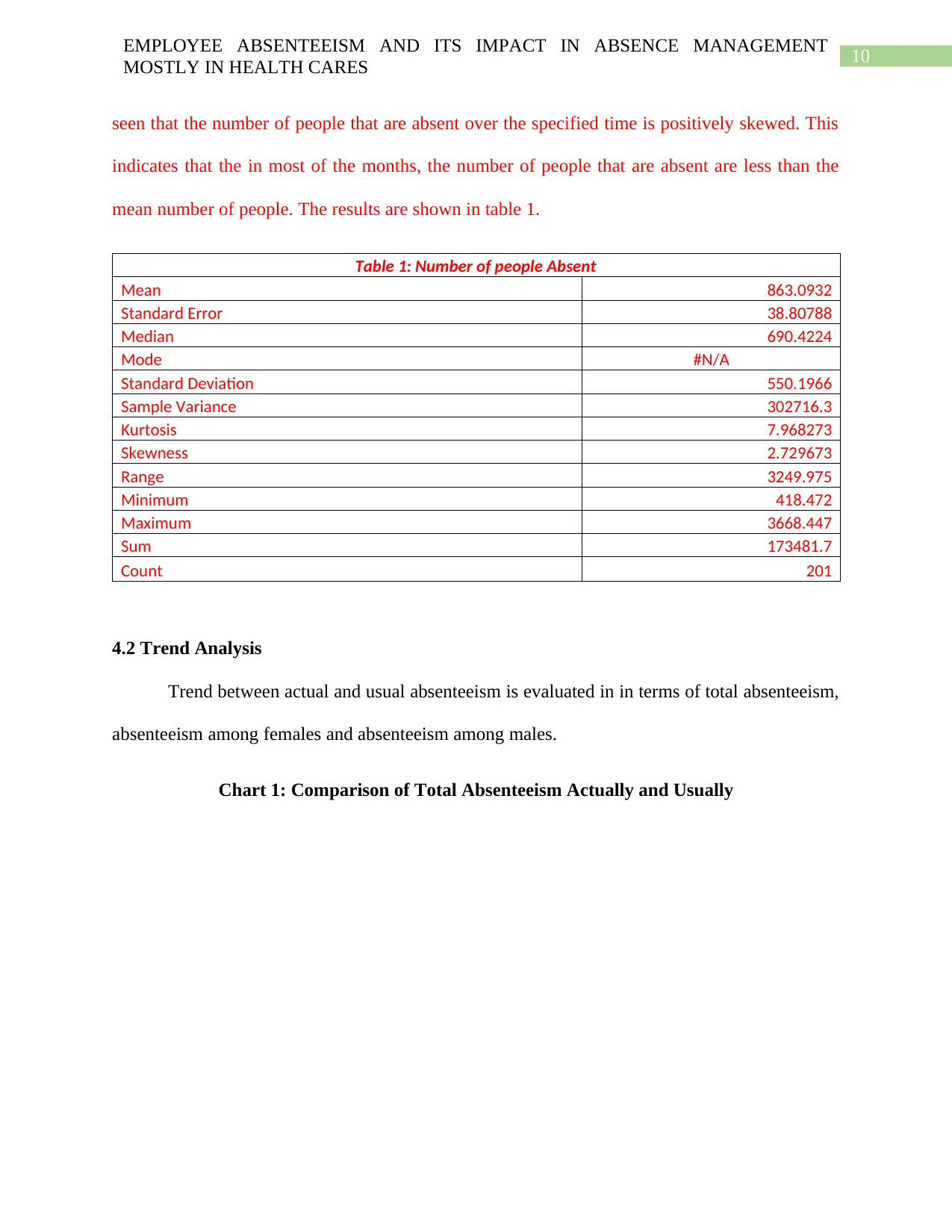
EMPLOYEE ABSENTEEISM AND ITS IMPACT IN ABSENCE MANAGEMENT
MOSTLY IN HEALTH CARES
seen that the number of people that are absent over the specified time is positively skewed. This
indicates that the in most of the months, the number of people that are absent are less than the
mean number of people. The results are shown in table 1.
Table 1: Number of people Absent
Mean 863.0932
Standard Error 38.80788
Median 690.4224
Mode #N/A
Standard Deviation 550.1966
Sample Variance 302716.3
Kurtosis 7.968273
Skewness 2.729673
Range 3249.975
Minimum 418.472
Maximum 3668.447
Sum 173481.7
Count 201
4.2 Trend Analysis
Trend between actual and usual absenteeism is evaluated in in terms of total absenteeism,
absenteeism among females and absenteeism among males.
Chart 1: Comparison of Total Absenteeism Actually and Usually
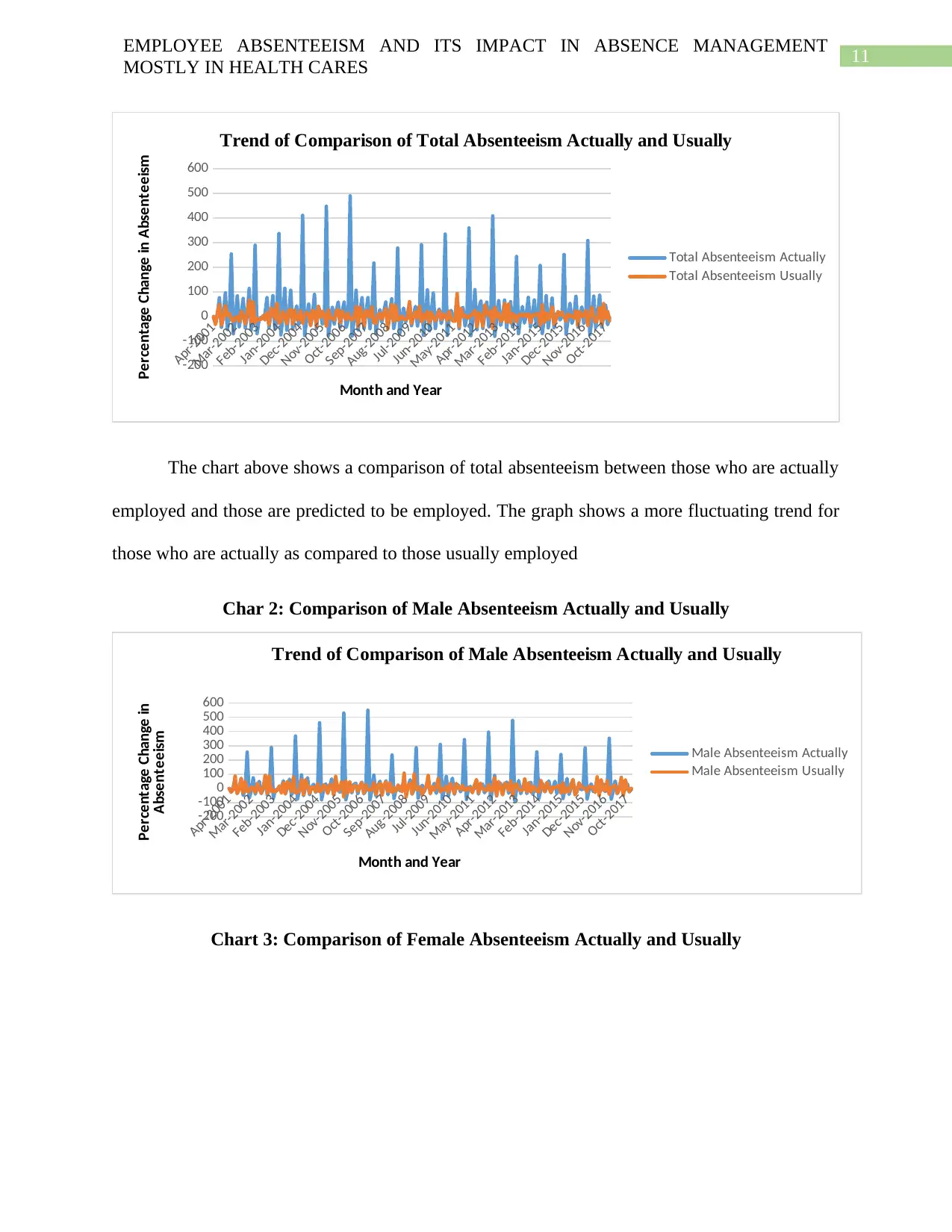
EMPLOYEE ABSENTEEISM AND ITS IMPACT IN ABSENCE MANAGEMENT
MOSTLY IN HEALTH CARES
Apr-2001
Mar-2002
Feb-2003
Jan-2004
Dec-2004
Nov-2005
Oct-2006
Sep-2007
Aug-2008
Jul-2009
Jun-2010
May-2011
Apr-2012
Mar-2013
Feb-2014
Jan-2015
Dec-2015
Nov-2016
Oct-2017
-200
-100
0
100
200
300
400
500
600
Trend of Comparison of Total Absenteeism Actually and Usually
Total Absenteeism Actually
Total Absenteeism Usually
Month and Year
Percentage Change in Absenteeism
The chart above shows a comparison of total absenteeism between those who are actually
employed and those are predicted to be employed. The graph shows a more fluctuating trend for
those who are actually as compared to those usually employed
Char 2: Comparison of Male Absenteeism Actually and Usually
Apr-2001
Mar-2002
Feb-2003
Jan-2004
Dec-2004
Nov-2005
Oct-2006
Sep-2007
Aug-2008
Jul-2009
Jun-2010
May-2011
Apr-2012
Mar-2013
Feb-2014
Jan-2015
Dec-2015
Nov-2016
Oct-2017
-200
-100
0
100
200
300
400
500
600
Trend of Comparison of Male Absenteeism Actually and Usually
Male Absenteeism Actually
Male Absenteeism Usually
Month and Year
Percentage Change in
Absenteeism
Chart 3: Comparison of Female Absenteeism Actually and Usually
⊘ This is a preview!⊘
Do you want full access?
Subscribe today to unlock all pages.

Trusted by 1+ million students worldwide
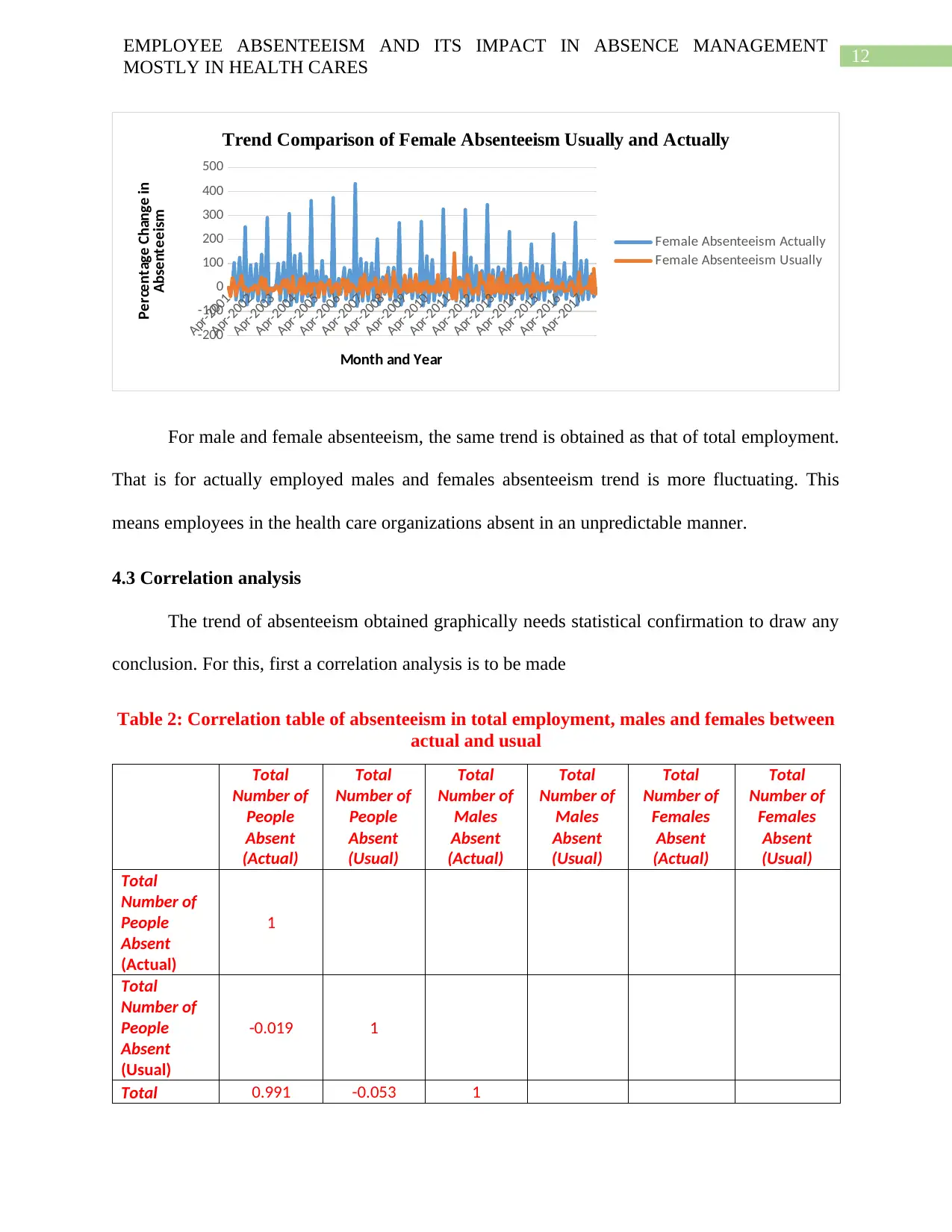
EMPLOYEE ABSENTEEISM AND ITS IMPACT IN ABSENCE MANAGEMENT
MOSTLY IN HEALTH CARES
Apr-2001
Apr-2002
Apr-2003
Apr-2004
Apr-2005
Apr-2006
Apr-2007
Apr-2008
Apr-2009
Apr-2010
Apr-2011
Apr-2012
Apr-2013
Apr-2014
Apr-2015
Apr-2016
Apr-2017
-200
-100
0
100
200
300
400
500
Trend Comparison of Female Absenteeism Usually and Actually
Female Absenteeism Actually
Female Absenteeism Usually
Month and Year
Percentage Change in
Absenteeism
For male and female absenteeism, the same trend is obtained as that of total employment.
That is for actually employed males and females absenteeism trend is more fluctuating. This
means employees in the health care organizations absent in an unpredictable manner.
4.3 Correlation analysis
The trend of absenteeism obtained graphically needs statistical confirmation to draw any
conclusion. For this, first a correlation analysis is to be made
Table 2: Correlation table of absenteeism in total employment, males and females between
actual and usual
Total
Number of
People
Absent
(Actual)
Total
Number of
People
Absent
(Usual)
Total
Number of
Males
Absent
(Actual)
Total
Number of
Males
Absent
(Usual)
Total
Number of
Females
Absent
(Actual)
Total
Number of
Females
Absent
(Usual)
Total
Number of
People
Absent
(Actual)
1
Total
Number of
People
Absent
(Usual)
-0.019 1
Total 0.991 -0.053 1
Paraphrase This Document
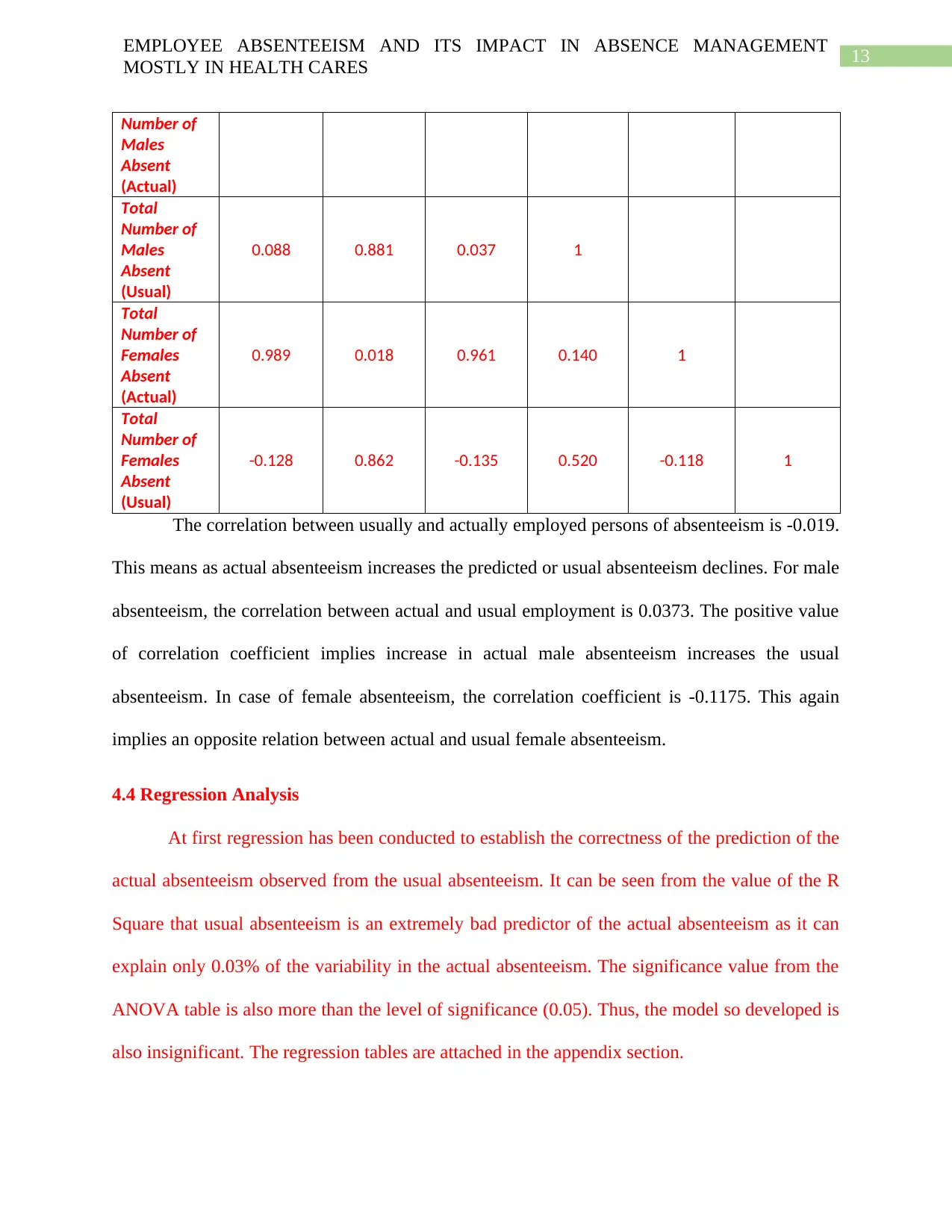
EMPLOYEE ABSENTEEISM AND ITS IMPACT IN ABSENCE MANAGEMENT
MOSTLY IN HEALTH CARES
Number of
Males
Absent
(Actual)
Total
Number of
Males
Absent
(Usual)
0.088 0.881 0.037 1
Total
Number of
Females
Absent
(Actual)
0.989 0.018 0.961 0.140 1
Total
Number of
Females
Absent
(Usual)
-0.128 0.862 -0.135 0.520 -0.118 1
The correlation between usually and actually employed persons of absenteeism is -0.019.
This means as actual absenteeism increases the predicted or usual absenteeism declines. For male
absenteeism, the correlation between actual and usual employment is 0.0373. The positive value
of correlation coefficient implies increase in actual male absenteeism increases the usual
absenteeism. In case of female absenteeism, the correlation coefficient is -0.1175. This again
implies an opposite relation between actual and usual female absenteeism.
4.4 Regression Analysis
At first regression has been conducted to establish the correctness of the prediction of the
actual absenteeism observed from the usual absenteeism. It can be seen from the value of the R
Square that usual absenteeism is an extremely bad predictor of the actual absenteeism as it can
explain only 0.03% of the variability in the actual absenteeism. The significance value from the
ANOVA table is also more than the level of significance (0.05). Thus, the model so developed is
also insignificant. The regression tables are attached in the appendix section.
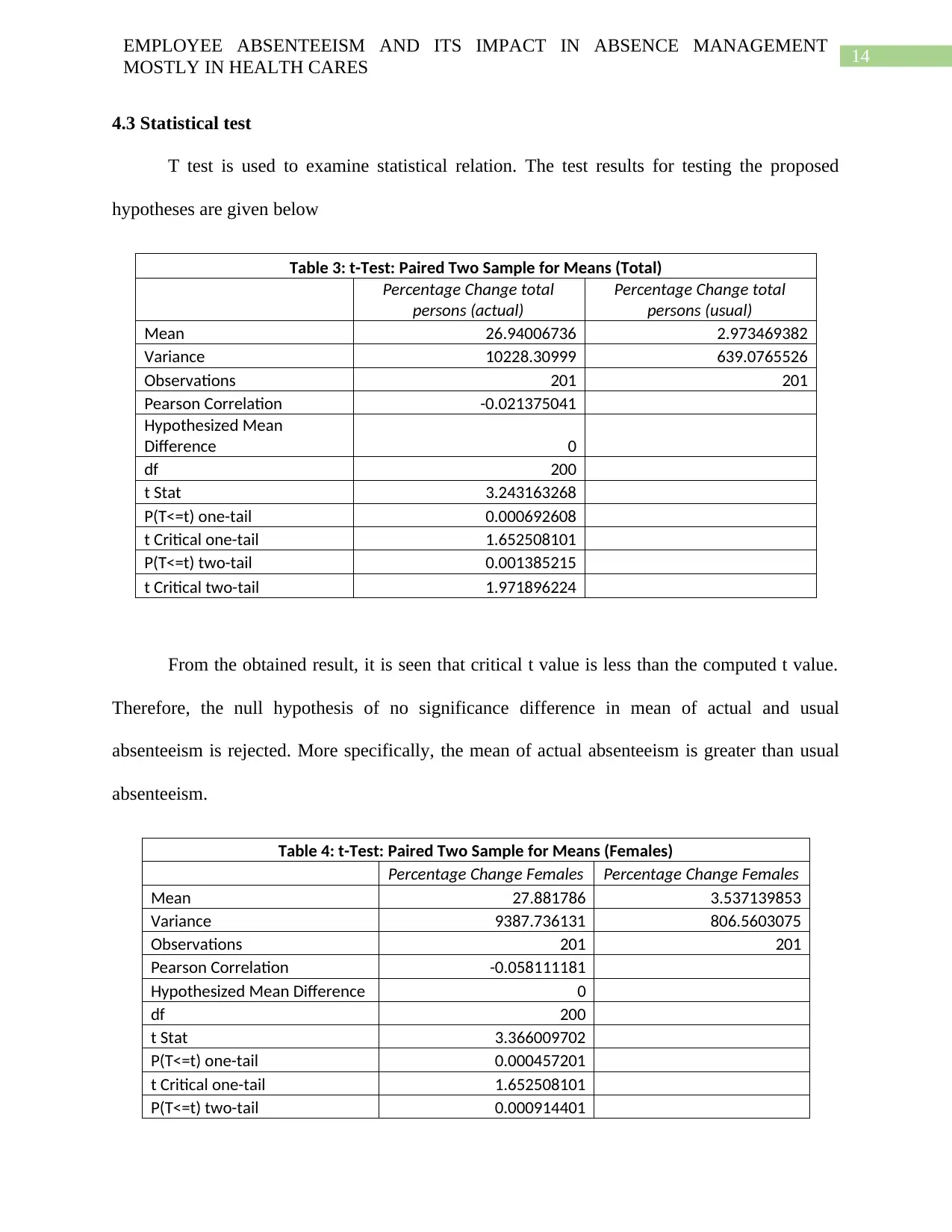
EMPLOYEE ABSENTEEISM AND ITS IMPACT IN ABSENCE MANAGEMENT
MOSTLY IN HEALTH CARES
4.3 Statistical test
T test is used to examine statistical relation. The test results for testing the proposed
hypotheses are given below
Table 3: t-Test: Paired Two Sample for Means (Total)
Percentage Change total
persons (actual)
Percentage Change total
persons (usual)
Mean 26.94006736 2.973469382
Variance 10228.30999 639.0765526
Observations 201 201
Pearson Correlation -0.021375041
Hypothesized Mean
Difference 0
df 200
t Stat 3.243163268
P(T<=t) one-tail 0.000692608
t Critical one-tail 1.652508101
P(T<=t) two-tail 0.001385215
t Critical two-tail 1.971896224
From the obtained result, it is seen that critical t value is less than the computed t value.
Therefore, the null hypothesis of no significance difference in mean of actual and usual
absenteeism is rejected. More specifically, the mean of actual absenteeism is greater than usual
absenteeism.
Table 4: t-Test: Paired Two Sample for Means (Females)
Percentage Change Females Percentage Change Females
Mean 27.881786 3.537139853
Variance 9387.736131 806.5603075
Observations 201 201
Pearson Correlation -0.058111181
Hypothesized Mean Difference 0
df 200
t Stat 3.366009702
P(T<=t) one-tail 0.000457201
t Critical one-tail 1.652508101
P(T<=t) two-tail 0.000914401
⊘ This is a preview!⊘
Do you want full access?
Subscribe today to unlock all pages.

Trusted by 1+ million students worldwide
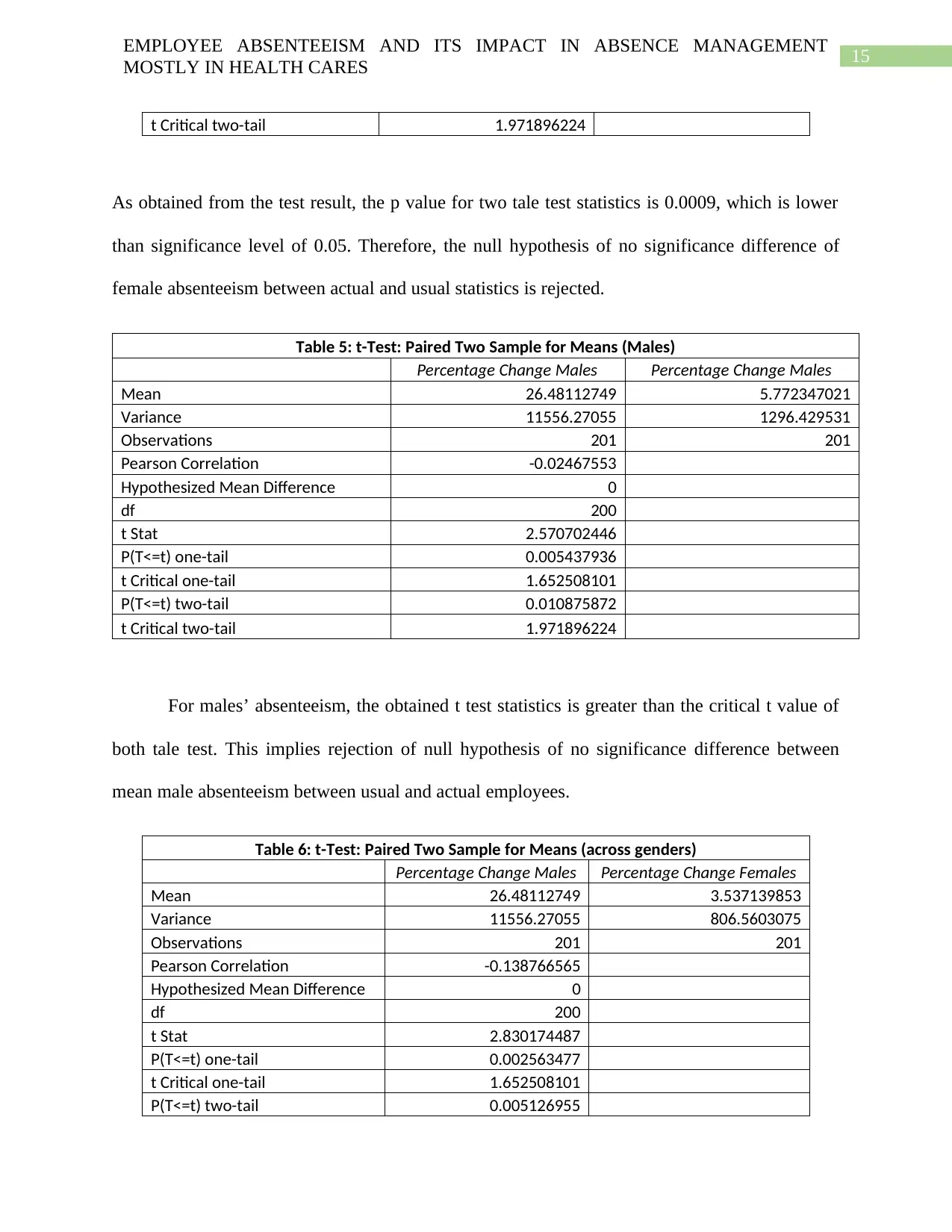
EMPLOYEE ABSENTEEISM AND ITS IMPACT IN ABSENCE MANAGEMENT
MOSTLY IN HEALTH CARES
t Critical two-tail 1.971896224
As obtained from the test result, the p value for two tale test statistics is 0.0009, which is lower
than significance level of 0.05. Therefore, the null hypothesis of no significance difference of
female absenteeism between actual and usual statistics is rejected.
Table 5: t-Test: Paired Two Sample for Means (Males)
Percentage Change Males Percentage Change Males
Mean 26.48112749 5.772347021
Variance 11556.27055 1296.429531
Observations 201 201
Pearson Correlation -0.02467553
Hypothesized Mean Difference 0
df 200
t Stat 2.570702446
P(T<=t) one-tail 0.005437936
t Critical one-tail 1.652508101
P(T<=t) two-tail 0.010875872
t Critical two-tail 1.971896224
For males’ absenteeism, the obtained t test statistics is greater than the critical t value of
both tale test. This implies rejection of null hypothesis of no significance difference between
mean male absenteeism between usual and actual employees.
Table 6: t-Test: Paired Two Sample for Means (across genders)
Percentage Change Males Percentage Change Females
Mean 26.48112749 3.537139853
Variance 11556.27055 806.5603075
Observations 201 201
Pearson Correlation -0.138766565
Hypothesized Mean Difference 0
df 200
t Stat 2.830174487
P(T<=t) one-tail 0.002563477
t Critical one-tail 1.652508101
P(T<=t) two-tail 0.005126955
Paraphrase This Document
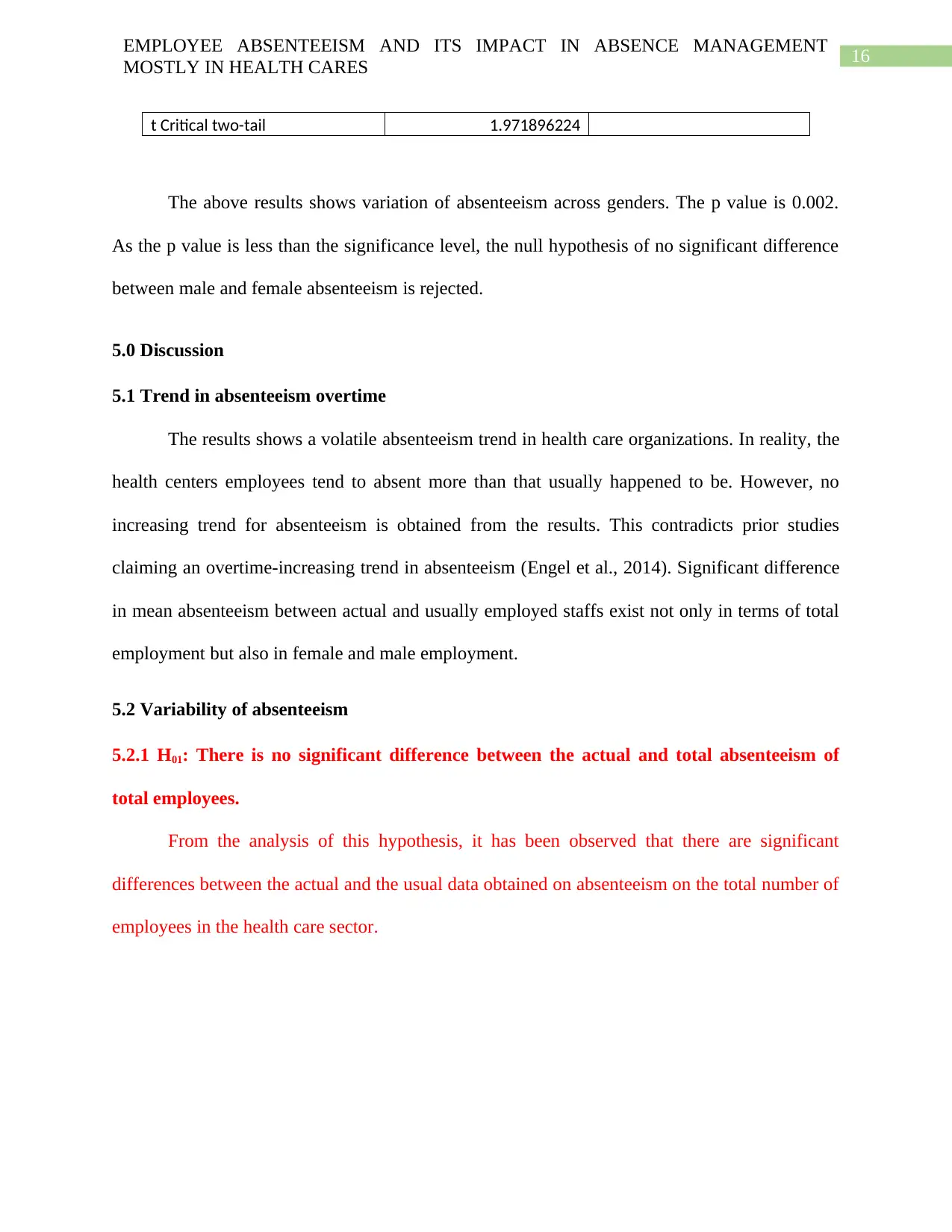
EMPLOYEE ABSENTEEISM AND ITS IMPACT IN ABSENCE MANAGEMENT
MOSTLY IN HEALTH CARES
t Critical two-tail 1.971896224
The above results shows variation of absenteeism across genders. The p value is 0.002.
As the p value is less than the significance level, the null hypothesis of no significant difference
between male and female absenteeism is rejected.
5.0 Discussion
5.1 Trend in absenteeism overtime
The results shows a volatile absenteeism trend in health care organizations. In reality, the
health centers employees tend to absent more than that usually happened to be. However, no
increasing trend for absenteeism is obtained from the results. This contradicts prior studies
claiming an overtime-increasing trend in absenteeism (Engel et al., 2014). Significant difference
in mean absenteeism between actual and usually employed staffs exist not only in terms of total
employment but also in female and male employment.
5.2 Variability of absenteeism
5.2.1 H01: There is no significant difference between the actual and total absenteeism of
total employees.
From the analysis of this hypothesis, it has been observed that there are significant
differences between the actual and the usual data obtained on absenteeism on the total number of
employees in the health care sector.
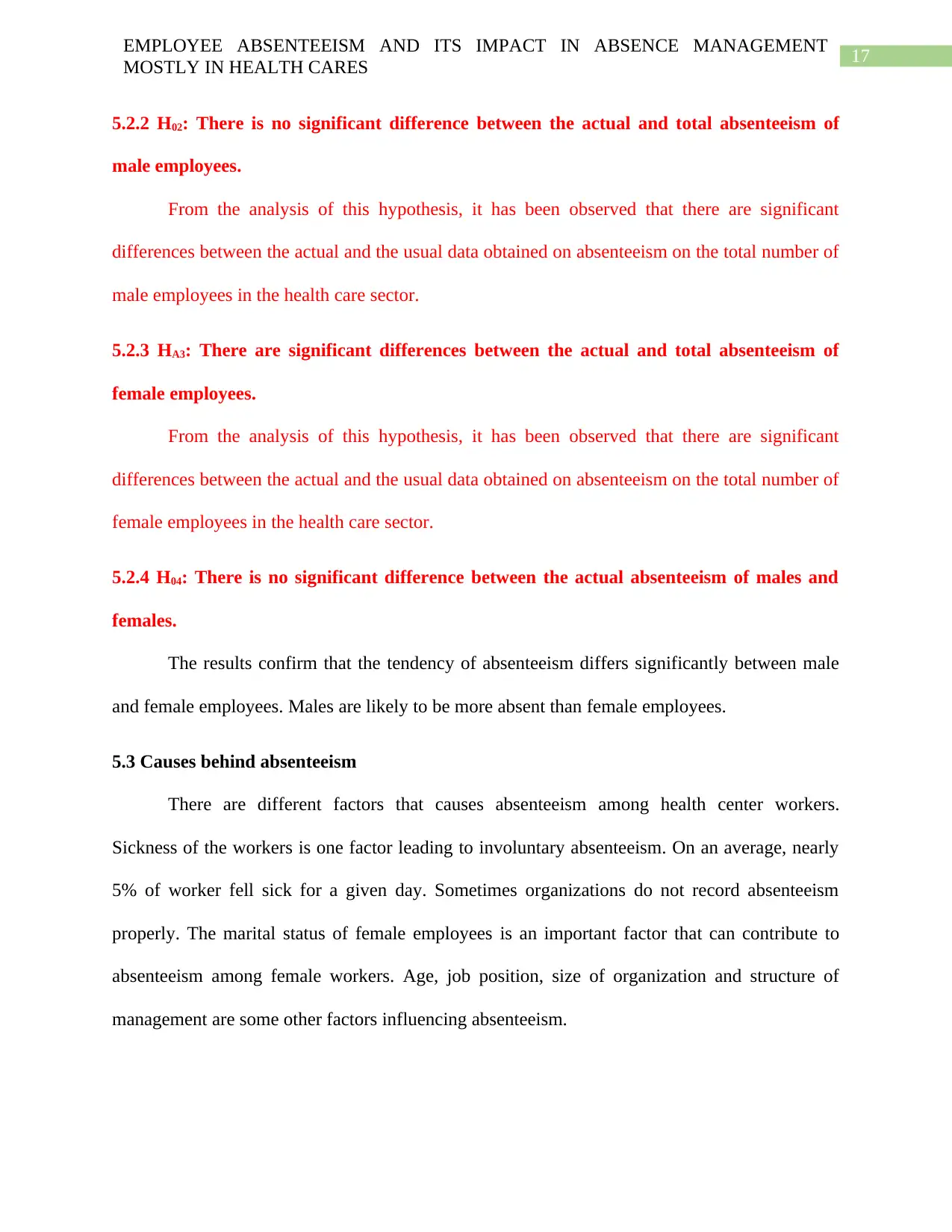
EMPLOYEE ABSENTEEISM AND ITS IMPACT IN ABSENCE MANAGEMENT
MOSTLY IN HEALTH CARES
5.2.2 H02: There is no significant difference between the actual and total absenteeism of
male employees.
From the analysis of this hypothesis, it has been observed that there are significant
differences between the actual and the usual data obtained on absenteeism on the total number of
male employees in the health care sector.
5.2.3 HA3: There are significant differences between the actual and total absenteeism of
female employees.
From the analysis of this hypothesis, it has been observed that there are significant
differences between the actual and the usual data obtained on absenteeism on the total number of
female employees in the health care sector.
5.2.4 H04: There is no significant difference between the actual absenteeism of males and
females.
The results confirm that the tendency of absenteeism differs significantly between male
and female employees. Males are likely to be more absent than female employees.
5.3 Causes behind absenteeism
There are different factors that causes absenteeism among health center workers.
Sickness of the workers is one factor leading to involuntary absenteeism. On an average, nearly
5% of worker fell sick for a given day. Sometimes organizations do not record absenteeism
properly. The marital status of female employees is an important factor that can contribute to
absenteeism among female workers. Age, job position, size of organization and structure of
management are some other factors influencing absenteeism.
⊘ This is a preview!⊘
Do you want full access?
Subscribe today to unlock all pages.

Trusted by 1+ million students worldwide
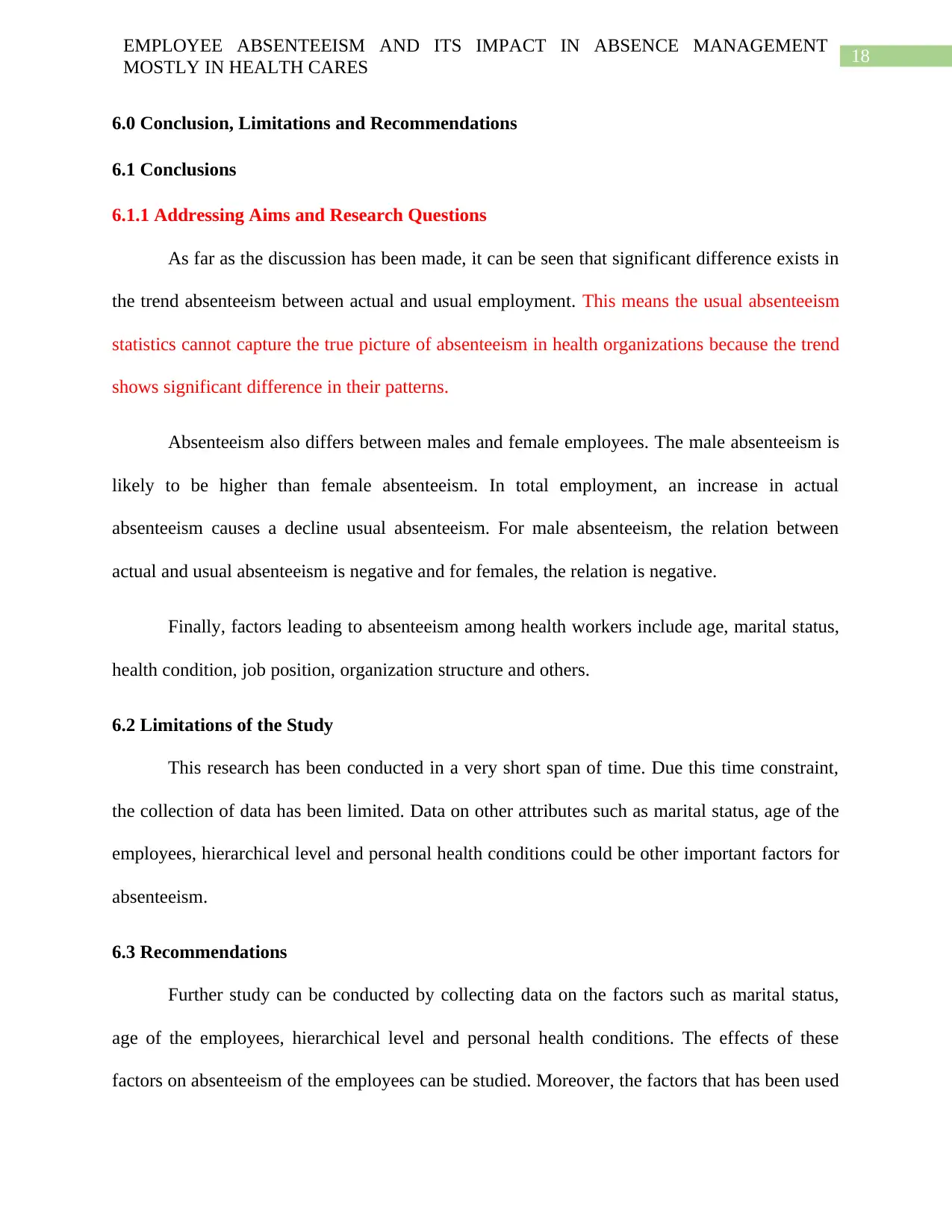
EMPLOYEE ABSENTEEISM AND ITS IMPACT IN ABSENCE MANAGEMENT
MOSTLY IN HEALTH CARES
6.0 Conclusion, Limitations and Recommendations
6.1 Conclusions
6.1.1 Addressing Aims and Research Questions
As far as the discussion has been made, it can be seen that significant difference exists in
the trend absenteeism between actual and usual employment. This means the usual absenteeism
statistics cannot capture the true picture of absenteeism in health organizations because the trend
shows significant difference in their patterns.
Absenteeism also differs between males and female employees. The male absenteeism is
likely to be higher than female absenteeism. In total employment, an increase in actual
absenteeism causes a decline usual absenteeism. For male absenteeism, the relation between
actual and usual absenteeism is negative and for females, the relation is negative.
Finally, factors leading to absenteeism among health workers include age, marital status,
health condition, job position, organization structure and others.
6.2 Limitations of the Study
This research has been conducted in a very short span of time. Due this time constraint,
the collection of data has been limited. Data on other attributes such as marital status, age of the
employees, hierarchical level and personal health conditions could be other important factors for
absenteeism.
6.3 Recommendations
Further study can be conducted by collecting data on the factors such as marital status,
age of the employees, hierarchical level and personal health conditions. The effects of these
factors on absenteeism of the employees can be studied. Moreover, the factors that has been used
Paraphrase This Document
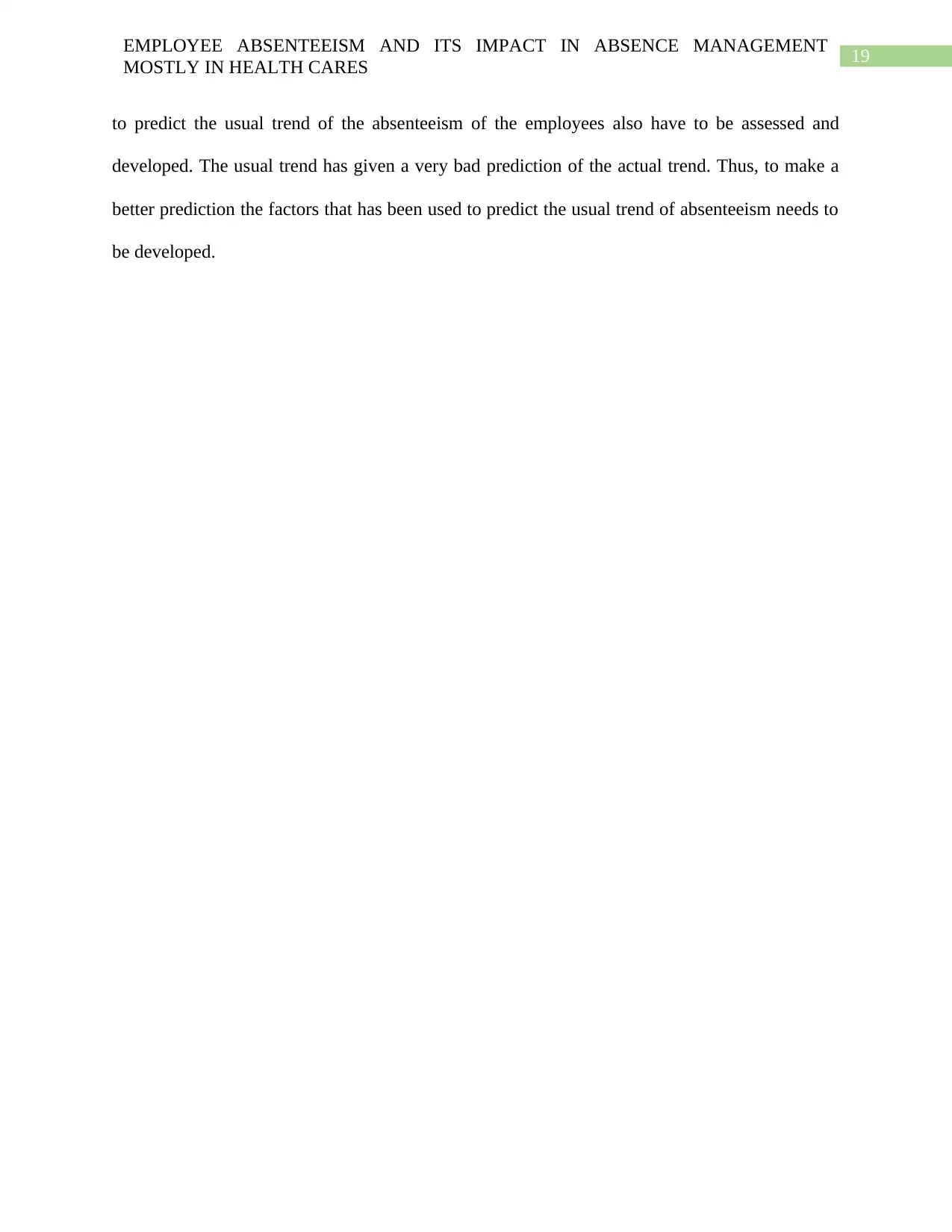
EMPLOYEE ABSENTEEISM AND ITS IMPACT IN ABSENCE MANAGEMENT
MOSTLY IN HEALTH CARES
to predict the usual trend of the absenteeism of the employees also have to be assessed and
developed. The usual trend has given a very bad prediction of the actual trend. Thus, to make a
better prediction the factors that has been used to predict the usual trend of absenteeism needs to
be developed.
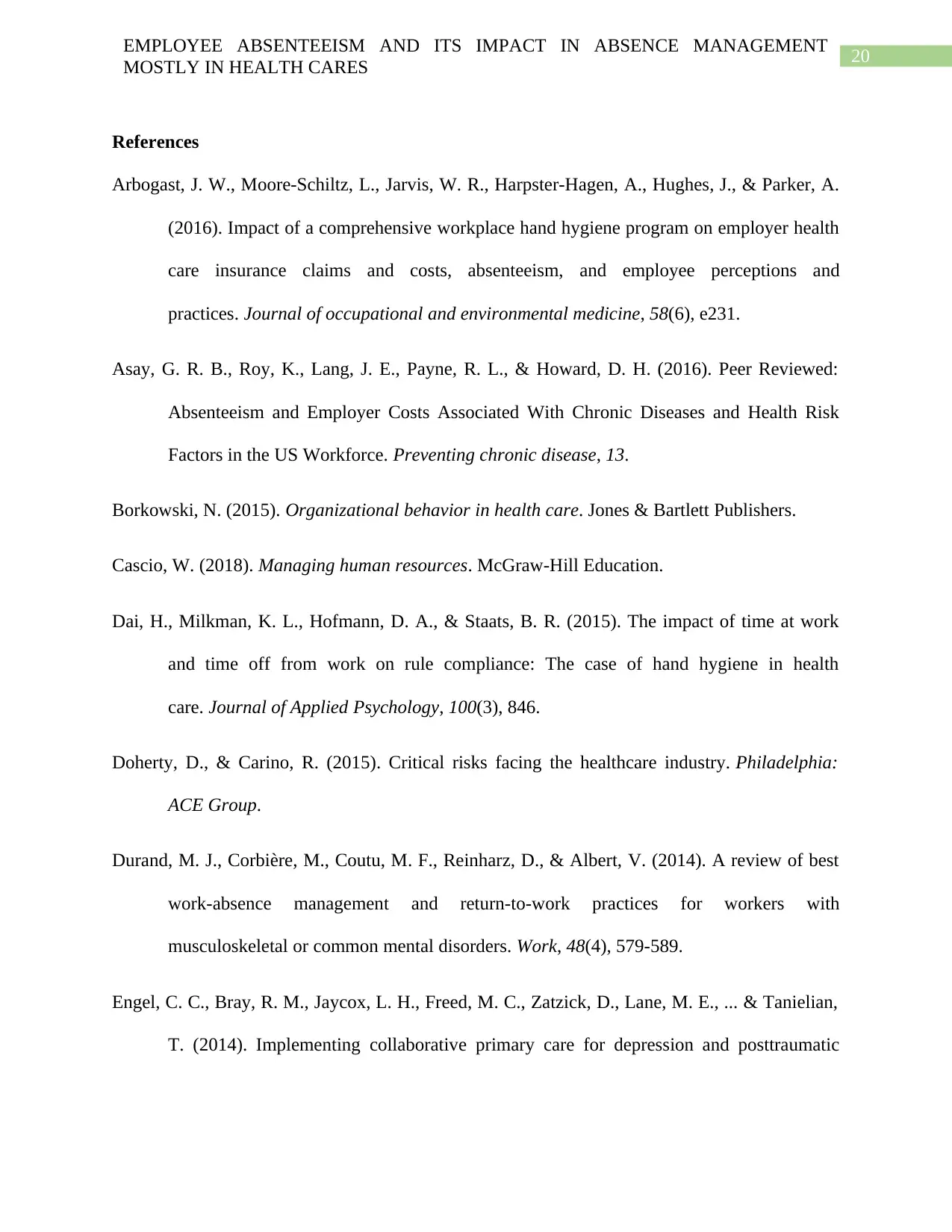
EMPLOYEE ABSENTEEISM AND ITS IMPACT IN ABSENCE MANAGEMENT
MOSTLY IN HEALTH CARES
References
Arbogast, J. W., Moore-Schiltz, L., Jarvis, W. R., Harpster-Hagen, A., Hughes, J., & Parker, A.
(2016). Impact of a comprehensive workplace hand hygiene program on employer health
care insurance claims and costs, absenteeism, and employee perceptions and
practices. Journal of occupational and environmental medicine, 58(6), e231.
Asay, G. R. B., Roy, K., Lang, J. E., Payne, R. L., & Howard, D. H. (2016). Peer Reviewed:
Absenteeism and Employer Costs Associated With Chronic Diseases and Health Risk
Factors in the US Workforce. Preventing chronic disease, 13.
Borkowski, N. (2015). Organizational behavior in health care. Jones & Bartlett Publishers.
Cascio, W. (2018). Managing human resources. McGraw-Hill Education.
Dai, H., Milkman, K. L., Hofmann, D. A., & Staats, B. R. (2015). The impact of time at work
and time off from work on rule compliance: The case of hand hygiene in health
care. Journal of Applied Psychology, 100(3), 846.
Doherty, D., & Carino, R. (2015). Critical risks facing the healthcare industry. Philadelphia:
ACE Group.
Durand, M. J., Corbière, M., Coutu, M. F., Reinharz, D., & Albert, V. (2014). A review of best
work-absence management and return-to-work practices for workers with
musculoskeletal or common mental disorders. Work, 48(4), 579-589.
Engel, C. C., Bray, R. M., Jaycox, L. H., Freed, M. C., Zatzick, D., Lane, M. E., ... & Tanielian,
T. (2014). Implementing collaborative primary care for depression and posttraumatic
⊘ This is a preview!⊘
Do you want full access?
Subscribe today to unlock all pages.

Trusted by 1+ million students worldwide
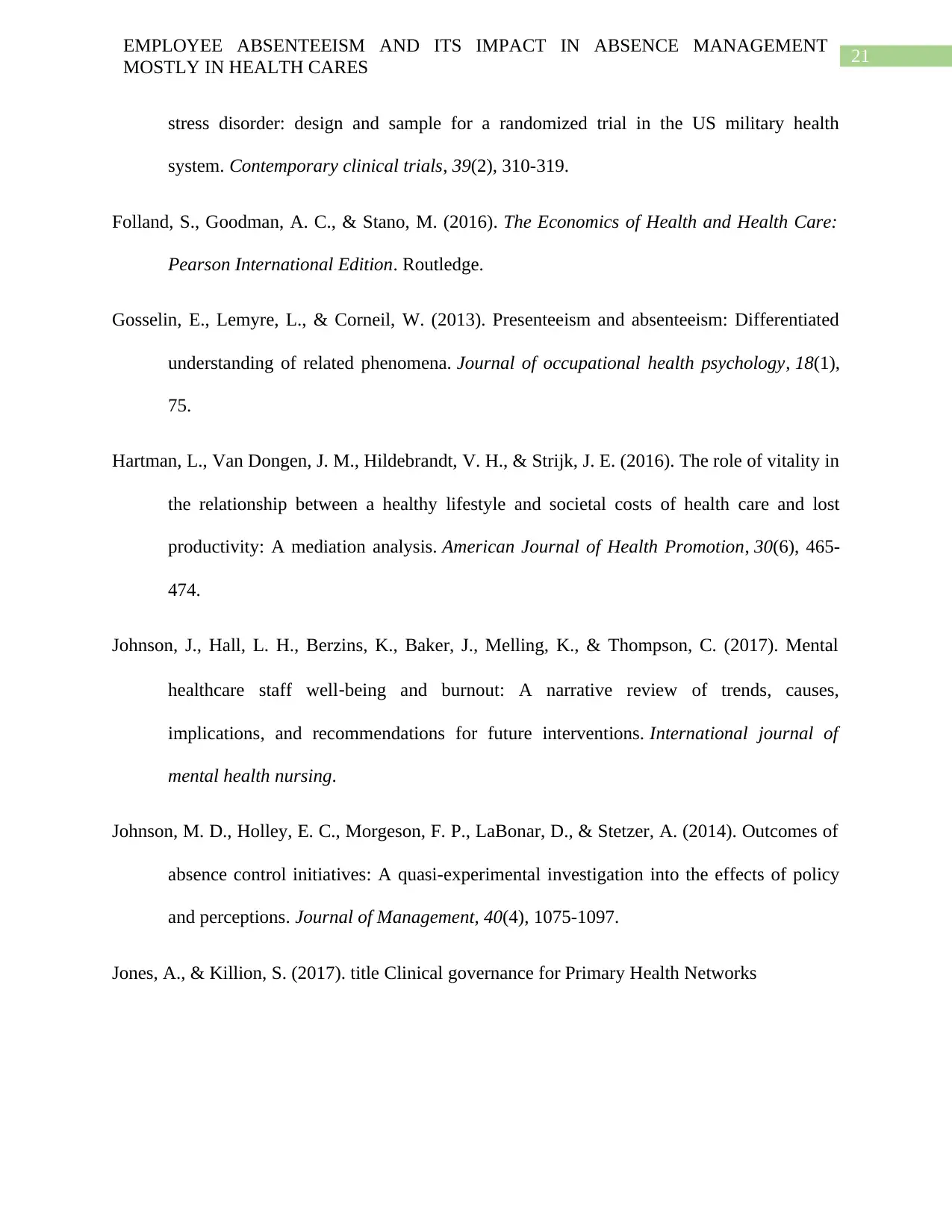
EMPLOYEE ABSENTEEISM AND ITS IMPACT IN ABSENCE MANAGEMENT
MOSTLY IN HEALTH CARES
stress disorder: design and sample for a randomized trial in the US military health
system. Contemporary clinical trials, 39(2), 310-319.
Folland, S., Goodman, A. C., & Stano, M. (2016). The Economics of Health and Health Care:
Pearson International Edition. Routledge.
Gosselin, E., Lemyre, L., & Corneil, W. (2013). Presenteeism and absenteeism: Differentiated
understanding of related phenomena. Journal of occupational health psychology, 18(1),
75.
Hartman, L., Van Dongen, J. M., Hildebrandt, V. H., & Strijk, J. E. (2016). The role of vitality in
the relationship between a healthy lifestyle and societal costs of health care and lost
productivity: A mediation analysis. American Journal of Health Promotion, 30(6), 465-
474.
Johnson, J., Hall, L. H., Berzins, K., Baker, J., Melling, K., & Thompson, C. (2017). Mental
healthcare staff well‐being and burnout: A narrative review of trends, causes,
implications, and recommendations for future interventions. International journal of
mental health nursing.
Johnson, M. D., Holley, E. C., Morgeson, F. P., LaBonar, D., & Stetzer, A. (2014). Outcomes of
absence control initiatives: A quasi-experimental investigation into the effects of policy
and perceptions. Journal of Management, 40(4), 1075-1097.
Jones, A., & Killion, S. (2017). title Clinical governance for Primary Health Networks
Paraphrase This Document
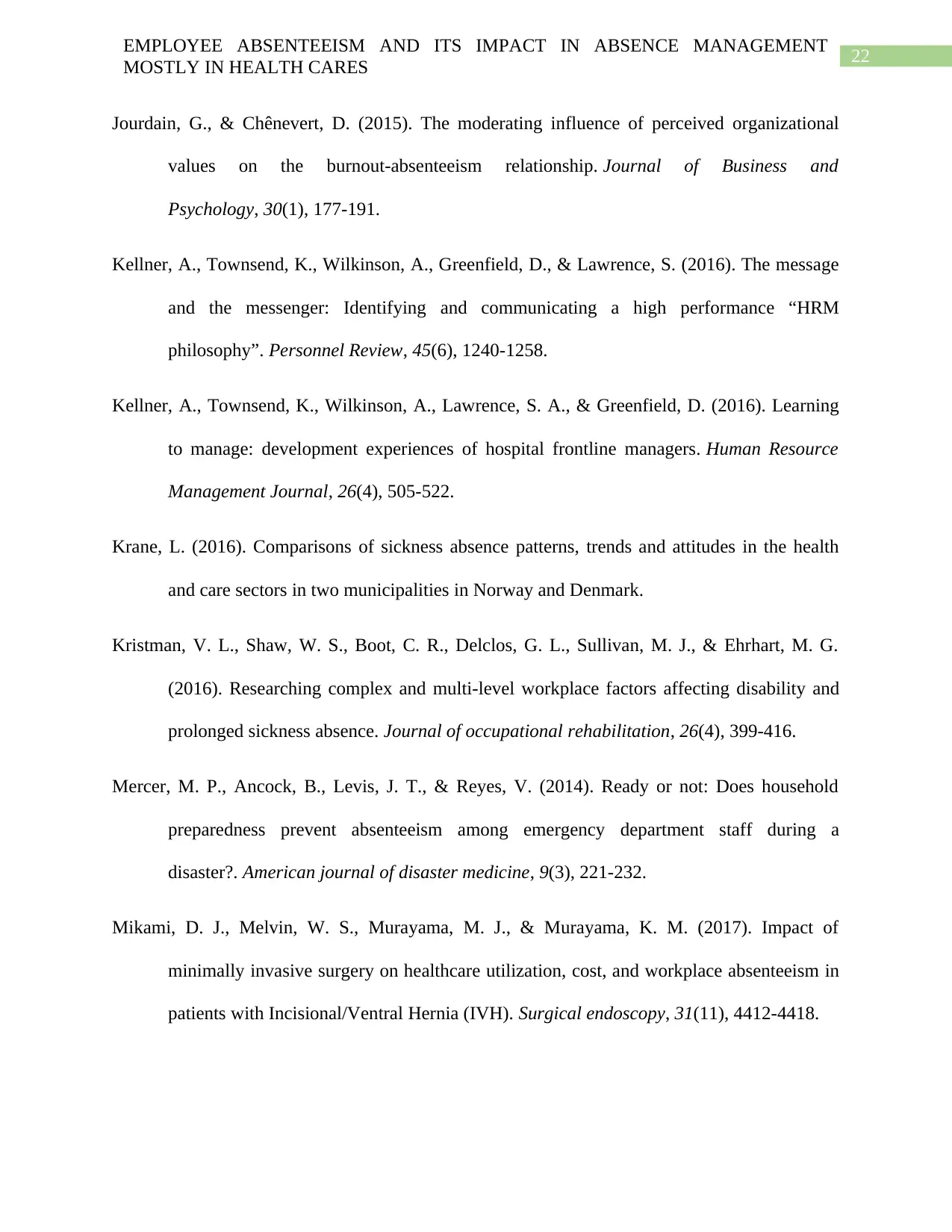
EMPLOYEE ABSENTEEISM AND ITS IMPACT IN ABSENCE MANAGEMENT
MOSTLY IN HEALTH CARES
Jourdain, G., & Chênevert, D. (2015). The moderating influence of perceived organizational
values on the burnout-absenteeism relationship. Journal of Business and
Psychology, 30(1), 177-191.
Kellner, A., Townsend, K., Wilkinson, A., Greenfield, D., & Lawrence, S. (2016). The message
and the messenger: Identifying and communicating a high performance “HRM
philosophy”. Personnel Review, 45(6), 1240-1258.
Kellner, A., Townsend, K., Wilkinson, A., Lawrence, S. A., & Greenfield, D. (2016). Learning
to manage: development experiences of hospital frontline managers. Human Resource
Management Journal, 26(4), 505-522.
Krane, L. (2016). Comparisons of sickness absence patterns, trends and attitudes in the health
and care sectors in two municipalities in Norway and Denmark.
Kristman, V. L., Shaw, W. S., Boot, C. R., Delclos, G. L., Sullivan, M. J., & Ehrhart, M. G.
(2016). Researching complex and multi-level workplace factors affecting disability and
prolonged sickness absence. Journal of occupational rehabilitation, 26(4), 399-416.
Mercer, M. P., Ancock, B., Levis, J. T., & Reyes, V. (2014). Ready or not: Does household
preparedness prevent absenteeism among emergency department staff during a
disaster?. American journal of disaster medicine, 9(3), 221-232.
Mikami, D. J., Melvin, W. S., Murayama, M. J., & Murayama, K. M. (2017). Impact of
minimally invasive surgery on healthcare utilization, cost, and workplace absenteeism in
patients with Incisional/Ventral Hernia (IVH). Surgical endoscopy, 31(11), 4412-4418.
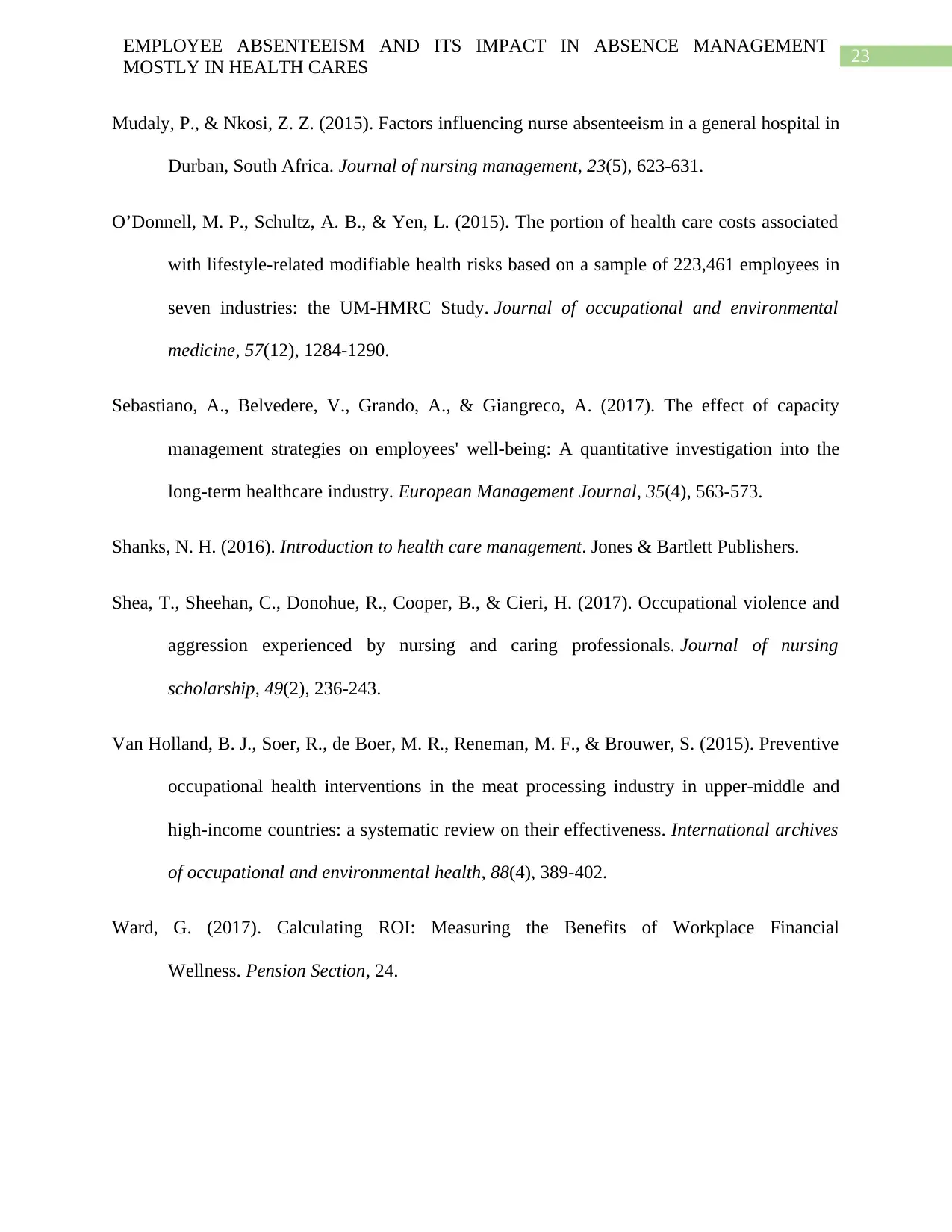
EMPLOYEE ABSENTEEISM AND ITS IMPACT IN ABSENCE MANAGEMENT
MOSTLY IN HEALTH CARES
Mudaly, P., & Nkosi, Z. Z. (2015). Factors influencing nurse absenteeism in a general hospital in
Durban, South Africa. Journal of nursing management, 23(5), 623-631.
O’Donnell, M. P., Schultz, A. B., & Yen, L. (2015). The portion of health care costs associated
with lifestyle-related modifiable health risks based on a sample of 223,461 employees in
seven industries: the UM-HMRC Study. Journal of occupational and environmental
medicine, 57(12), 1284-1290.
Sebastiano, A., Belvedere, V., Grando, A., & Giangreco, A. (2017). The effect of capacity
management strategies on employees' well-being: A quantitative investigation into the
long-term healthcare industry. European Management Journal, 35(4), 563-573.
Shanks, N. H. (2016). Introduction to health care management. Jones & Bartlett Publishers.
Shea, T., Sheehan, C., Donohue, R., Cooper, B., & Cieri, H. (2017). Occupational violence and
aggression experienced by nursing and caring professionals. Journal of nursing
scholarship, 49(2), 236-243.
Van Holland, B. J., Soer, R., de Boer, M. R., Reneman, M. F., & Brouwer, S. (2015). Preventive
occupational health interventions in the meat processing industry in upper-middle and
high-income countries: a systematic review on their effectiveness. International archives
of occupational and environmental health, 88(4), 389-402.
Ward, G. (2017). Calculating ROI: Measuring the Benefits of Workplace Financial
Wellness. Pension Section, 24.
⊘ This is a preview!⊘
Do you want full access?
Subscribe today to unlock all pages.

Trusted by 1+ million students worldwide

EMPLOYEE ABSENTEEISM AND ITS IMPACT IN ABSENCE MANAGEMENT
MOSTLY IN HEALTH CARES
Winwood, P. C., Stevens, F., & Bowden, R. (2015). The role of psychosocial safety climate in
job stress and work-related injury: observations of the Australian aged care industry. Job
stress: Risk factors, health effects and coping strategies, 107-136.
Zboril-Benson, L. R. (2016). Why nurses are calling in sick: the impact of health-care
restructuring. Canadian Journal of Nursing Research Archive, 33(4).
Paraphrase This Document
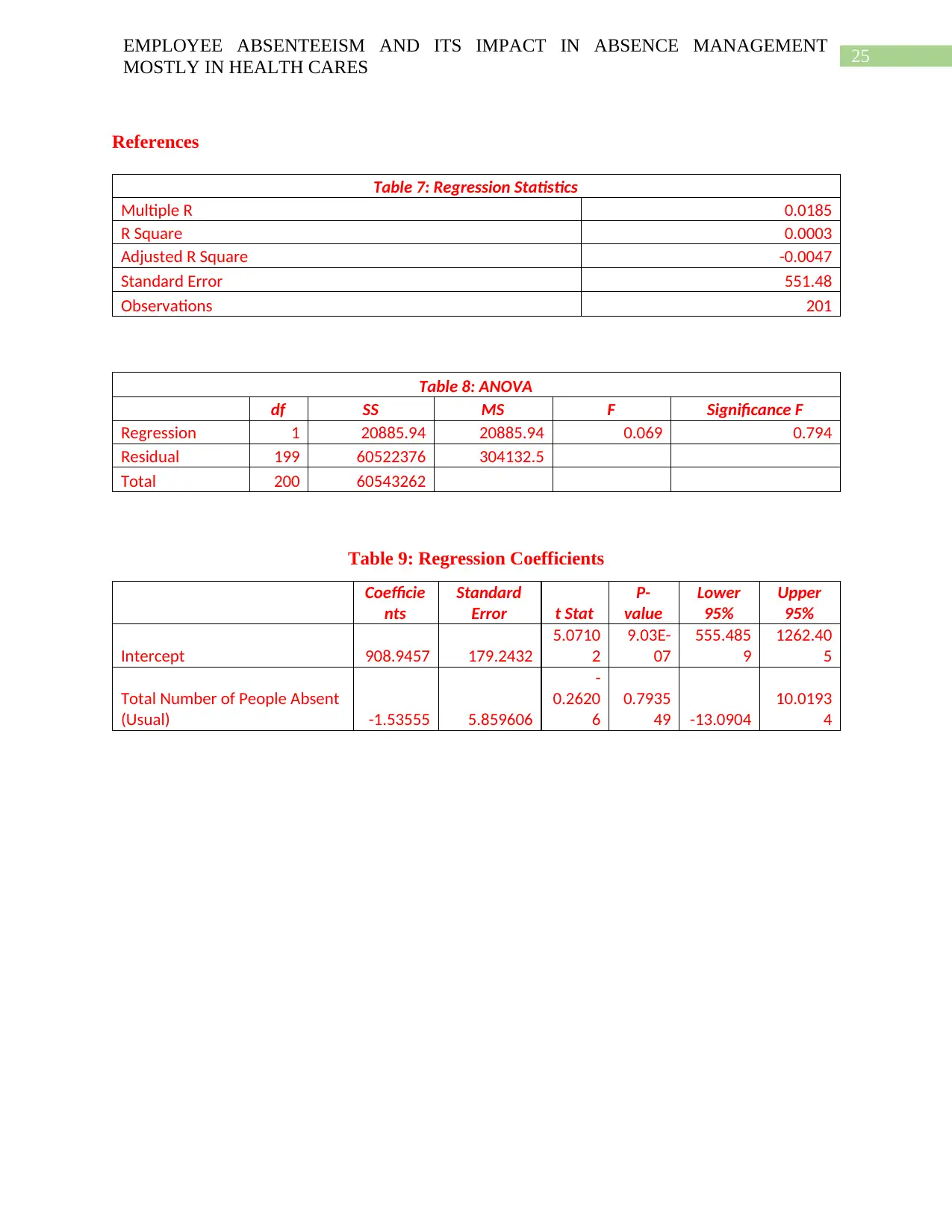
EMPLOYEE ABSENTEEISM AND ITS IMPACT IN ABSENCE MANAGEMENT
MOSTLY IN HEALTH CARES
References
Table 7: Regression Statistics
Multiple R 0.0185
R Square 0.0003
Adjusted R Square -0.0047
Standard Error 551.48
Observations 201
Table 8: ANOVA
df SS MS F Significance F
Regression 1 20885.94 20885.94 0.069 0.794
Residual 199 60522376 304132.5
Total 200 60543262
Table 9: Regression Coefficients
Coefficie
nts
Standard
Error t Stat
P-
value
Lower
95%
Upper
95%
Intercept 908.9457 179.2432
5.0710
2
9.03E-
07
555.485
9
1262.40
5
Total Number of People Absent
(Usual) -1.53555 5.859606
-
0.2620
6
0.7935
49 -13.0904
10.0193
4
Related Documents
Your All-in-One AI-Powered Toolkit for Academic Success.
+13062052269
info@desklib.com
Available 24*7 on WhatsApp / Email
![[object Object]](/_next/static/media/star-bottom.7253800d.svg)
© 2024 | Zucol Services PVT LTD | All rights reserved.





